Special Report
25 Largest (and 25 Smallest) National Parks
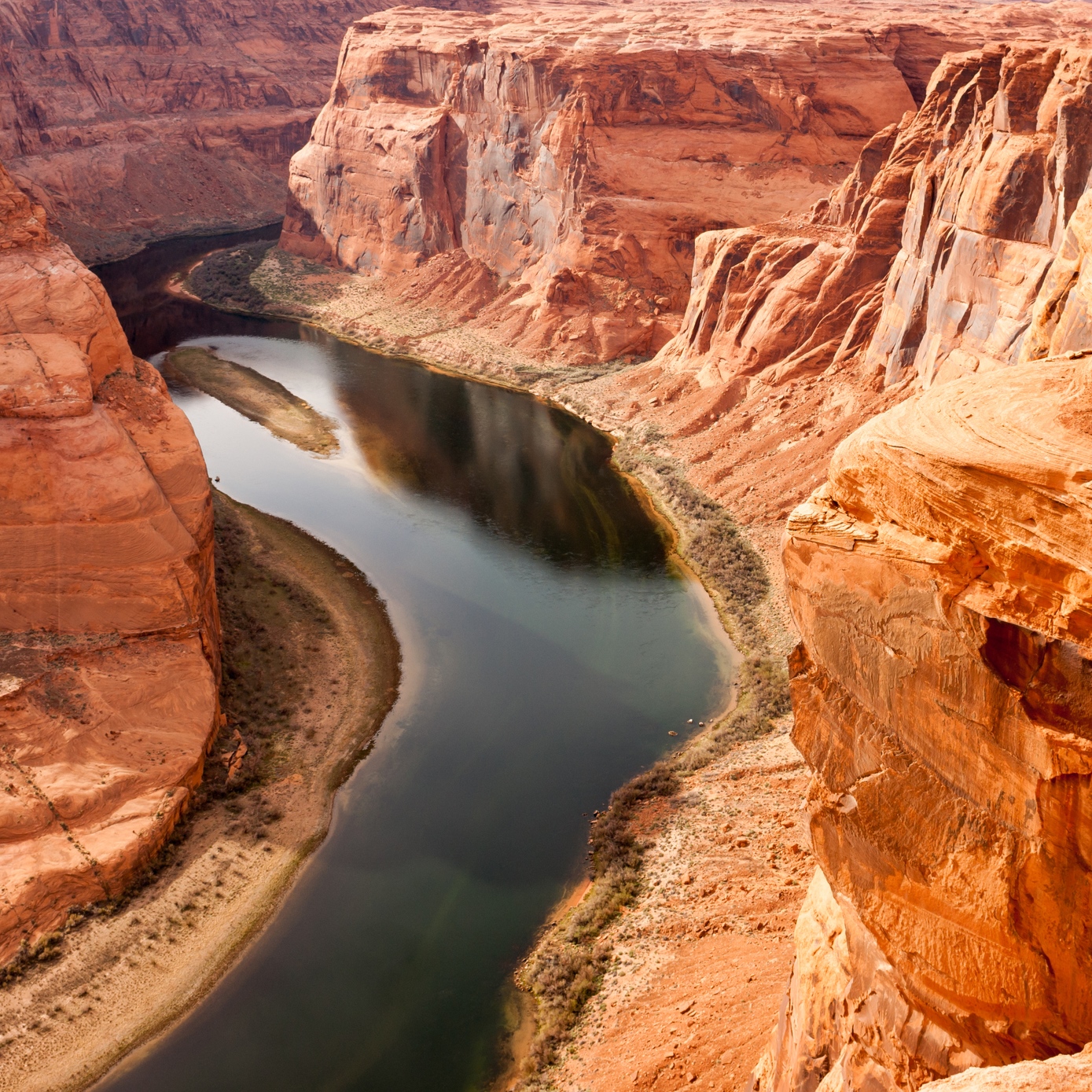
Published:
Last Updated:

Interest in national parks has been soaring in recent years. In fact, total visits to U.S. national parks exceeded the population of the nation in 2016 alone. Exploring the wilderness, hiking through mountains and sleeping under the stars are just some of the experiences visitors to U.S. national parks can share with the pioneers who built the country.
The national park concept was an idea championed by Theodore Roosevelt. As president, Roosevelt protected about 230 million acres of public land and signed into law the 1906 American Antiquities Act. This act set aside certain public natural areas as park and conservation land to be preserved for historic and scientific interest. These areas were designated as national monuments. Ten years later, Congress passed the Organic Act, creating the National Park Service.
While Americans approve of preserving their land, setting aside areas as national parks and monuments has sparked controversy in the past, sometimes pitting conservationists against ranchers, developers, and even tourists. The latest chapter in this sometimes contentious issue involves the Trump administration, which is considering shrinking the size of more than two dozen national monuments and turning over the space for private use.
24/7 Wall St. reviewed the size of all the national parks, historical parks, recreational areas and national monuments in the country to determine their size using data provided by the National Park Service.
With over 14 official designations and several unique titles, the National Park Service is very specific when it comes to defining their parks. Generally, the smaller national parks tend to have a greater connection to the country’s history, such as the birthplace of Abraham Lincoln or Minute Man National Historical Park, which commemorates the start of the American Revolution. The larger parks are places of refuge and stunning natural beauty, like the Grand Canyon or Sequoia National Park.
Alaska, the nation’s largest state, has four of the country’s 10 biggest national parks. These four parks combined account for 18 million acres — about the size of South Carolina.
Click here to see the 25 largest national parks.
Click here to see the 25 smallest national parks.
To identify the 25 largest and 25 smallest national parks and recreational areas in the United States, 24/7 Wall St. reviewed the gross area acres as of 2016 from the National Park Service. The NPS aggregates land area data for various different government land designations. Of these, only National Parks, National Recreational Areas and National Historical Parks were considered for our analysis. To avoid double counting land area, designations such as national monuments and historic sites, which are frequently contained within national parks and often limited to single structures, were excluded. We also did not consider National Preserves, which are sites intended for commercial big game hunting. Privately owned land figures also came from the NPS. Annual visitation data for each area from 2011 through 2016 was also obtained from the NPS.
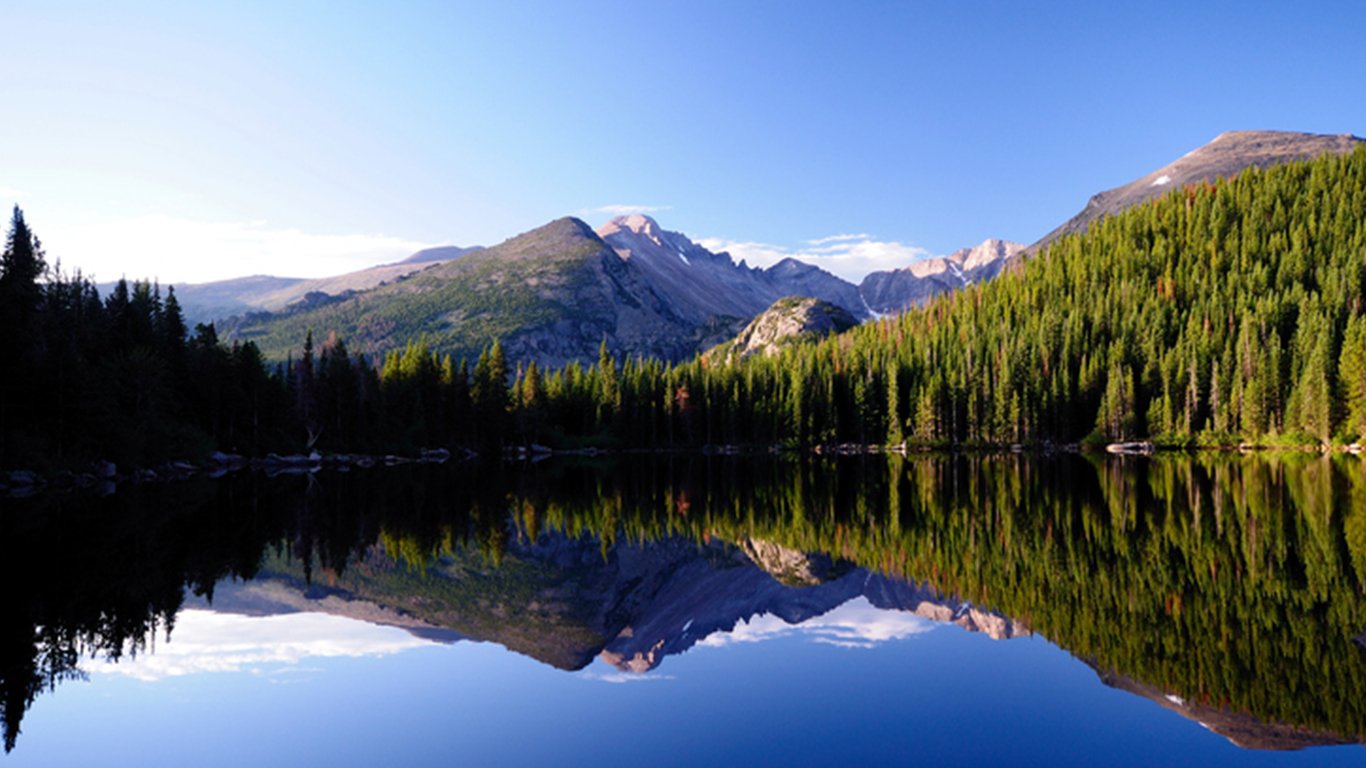
25. Rocky Mountain National Park
> Total land area: 265,795 acres
> State: Colorado
> Privately owned land: 248 acres
> 5-year change in tourism: +42%
Rocky Mountain National Park is full of hiking trails, 355 miles of them to be exact. If hiking isn’t for you, you can still witness the mountainous terrain through your car window. The roads wind along lowland meadows, rivers, all the way up to the subalpine forests. By the end of your journey, you will have ascended 12,000 feet and taken in a great deal of nature.
[in-text-ad]
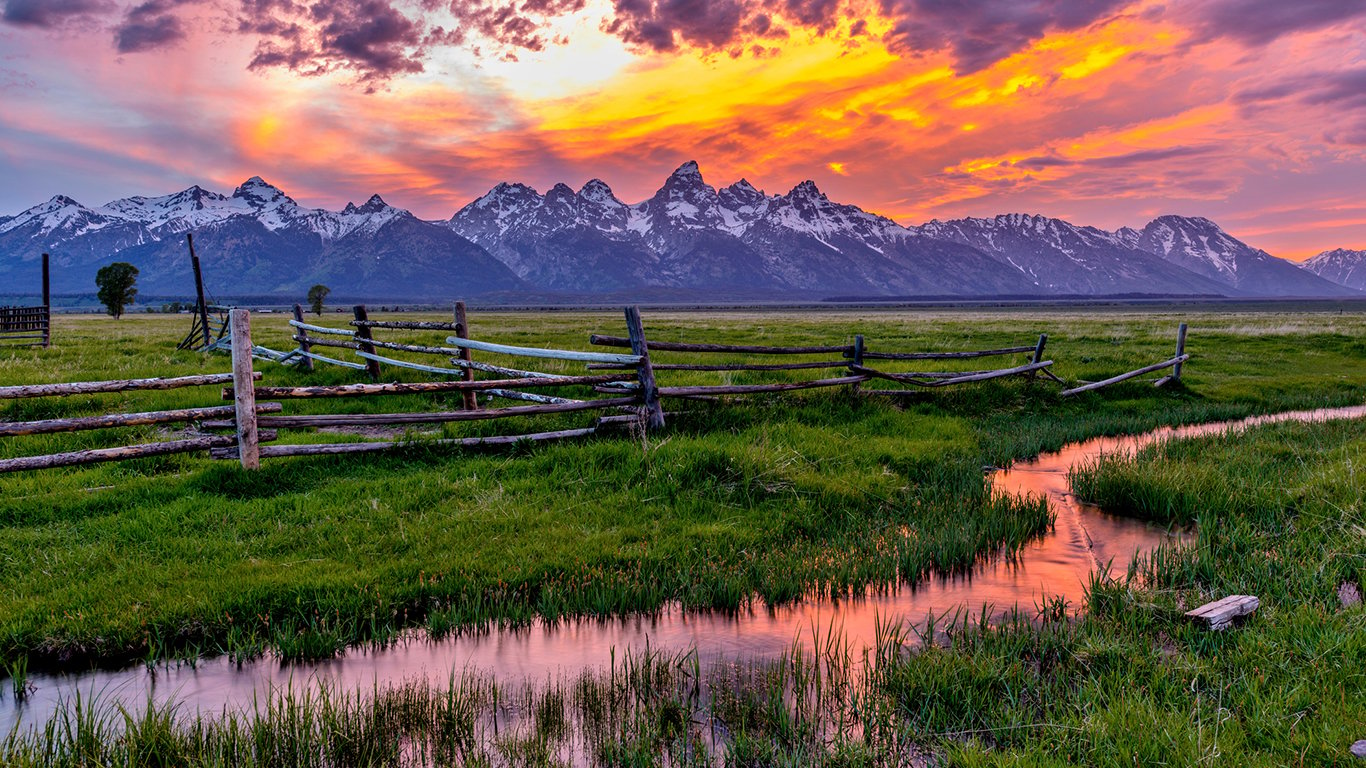
24. Grand Teton National Park
> Total land area: 310,044 acres
> State: Wyoming
> Privately owned land: 920 acres
> 5-year change in tourism: +26%
Grand Teton National Park has had human inhabitants for at least 11,000 years, when the last glaciers from the ice age melted. Philanthropist John D. Rockefeller, Jr. was a great fan of the park’s peaks, lakes and valleys, and a 24,000-acre parcel was dedicated to his memory.
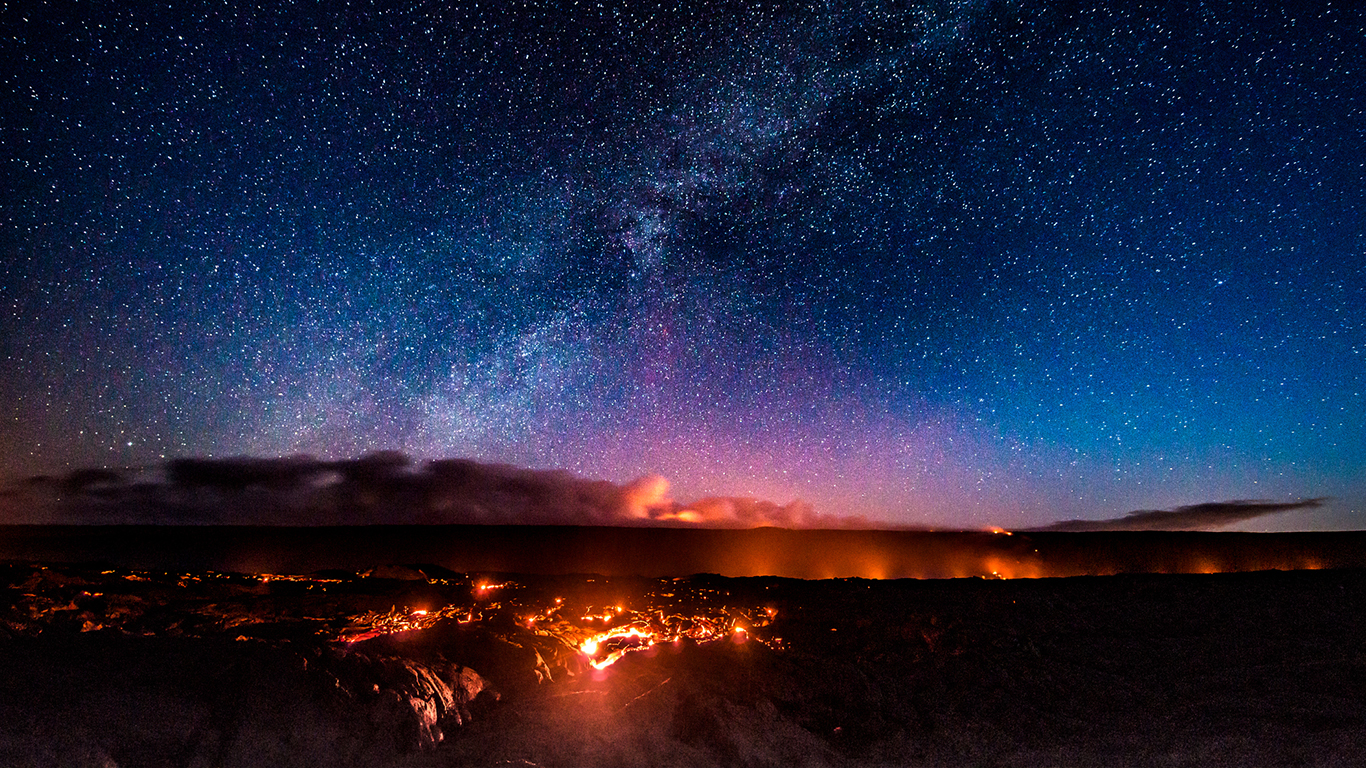
23. Hawaii Volcanoes National Park
> Total land area: 323,431 acres
> State: Hawaii
> Privately owned land: No private land
> 5-year change in tourism: +40%
The mission of Hawaii Volcanoes National Park is to protect, conserve, and study volcanic landscapes, and to permit safe public access to active volcanoes, diverse geographic settings, and wilderness. The park includes two of the world’s most active volcanoes, Kīlauea and Mauna Loa.
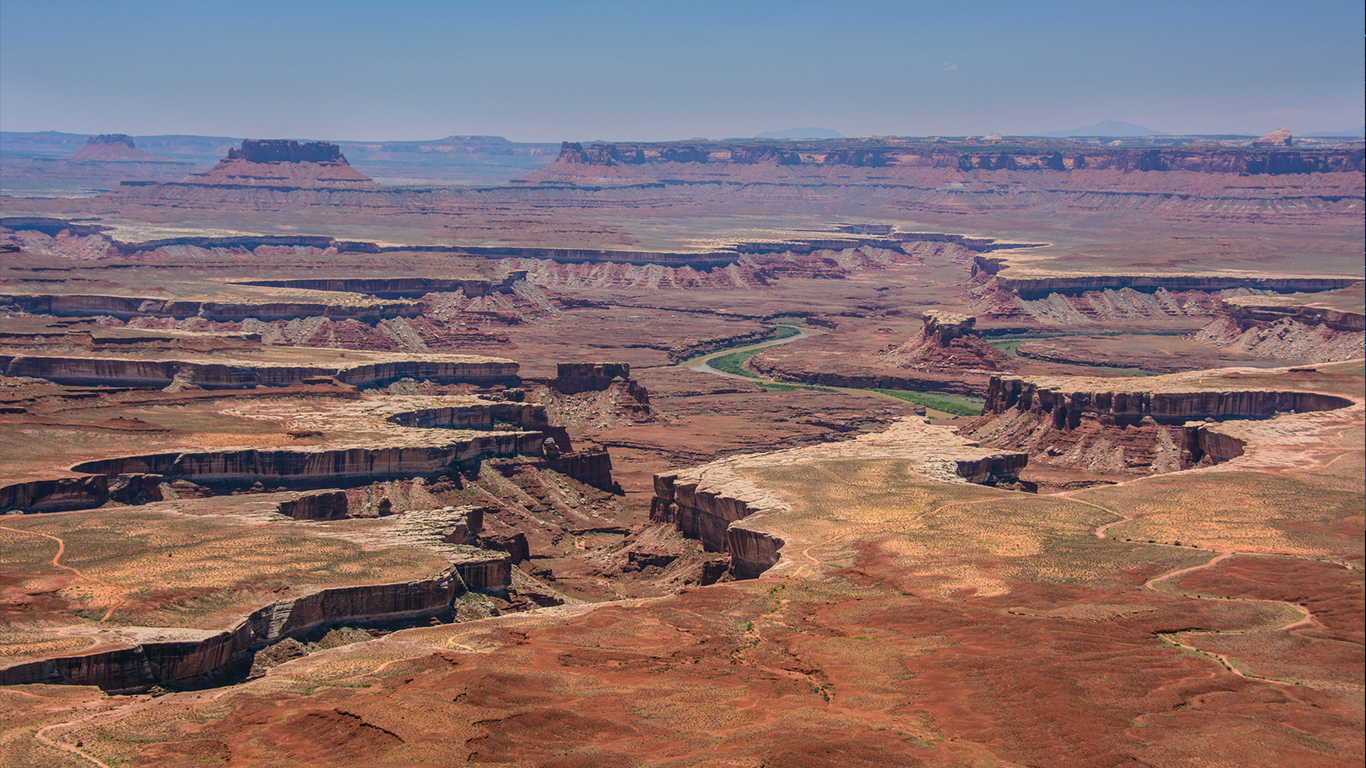
22. Canyonlands National Park
> Total land area: 337,598 acres
> State: Utah
> Privately owned land: No private land
> 5-year change in tourism: +64%
Canyonlands National Park offers a plethora of activities, including biking, boating, horseback riding and, when the sun goes down, stargazing. People have lived and roamed through this area for more than 10,000 years. A newer addition, Horseshoe Canyon, was introduced to the park in 1971 and is known to have some of the most impressive rock art in all of North America.
[in-text-ad-2]
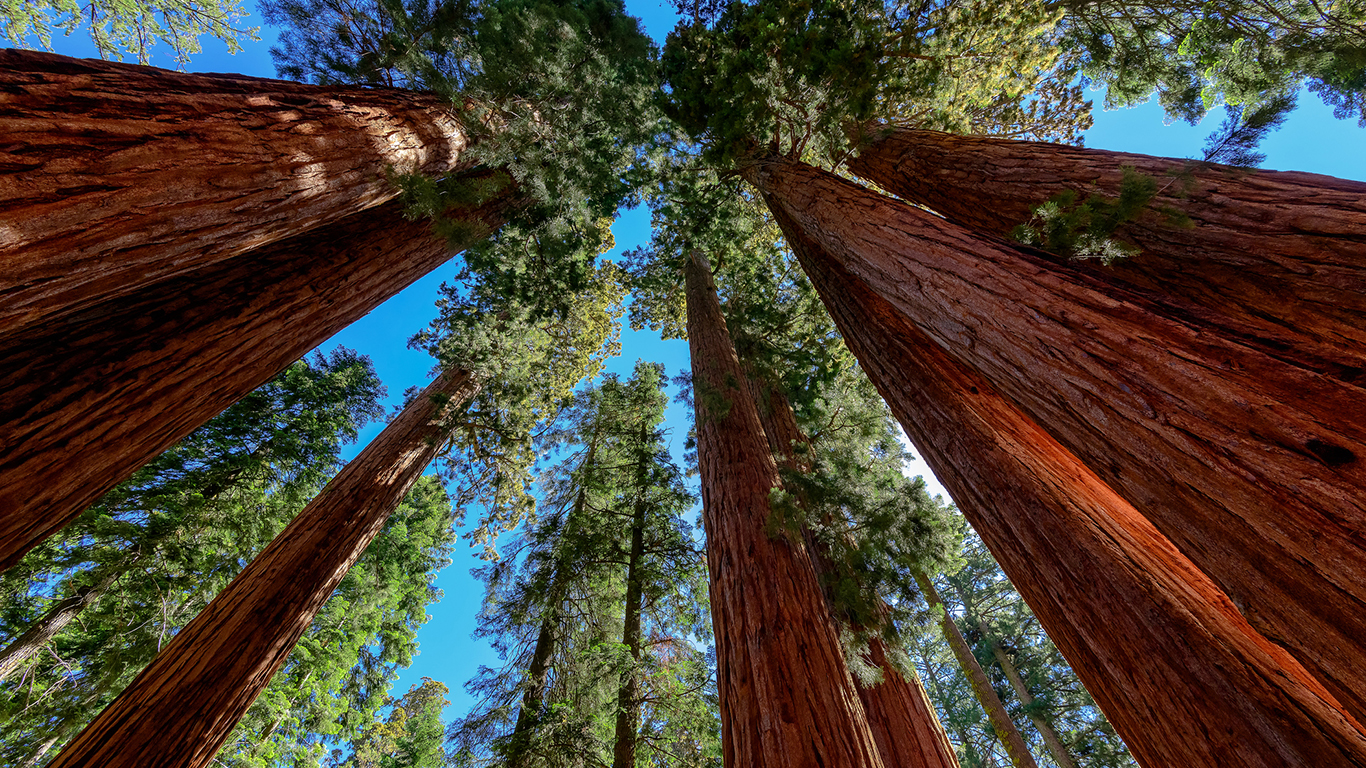
21. Sequoia National Park
> Total land area: 404,063 acres
> State: California
> Privately owned land: 154 acres
> 5-year change in tourism: +25%
This park has grown to great heights. Besides being the home of the 2,200-year-old General Sherman Tree, the tallest tree in the world at 275 feet, Sequoia National Park also shares a border with Mount Whitney — the tallest mountain in the continental U.S. Viewing these wonders was made easier for visitors e because of Captain Charles Young and his Buffalo soldiers, who built roads and trails in the early years of this national park.
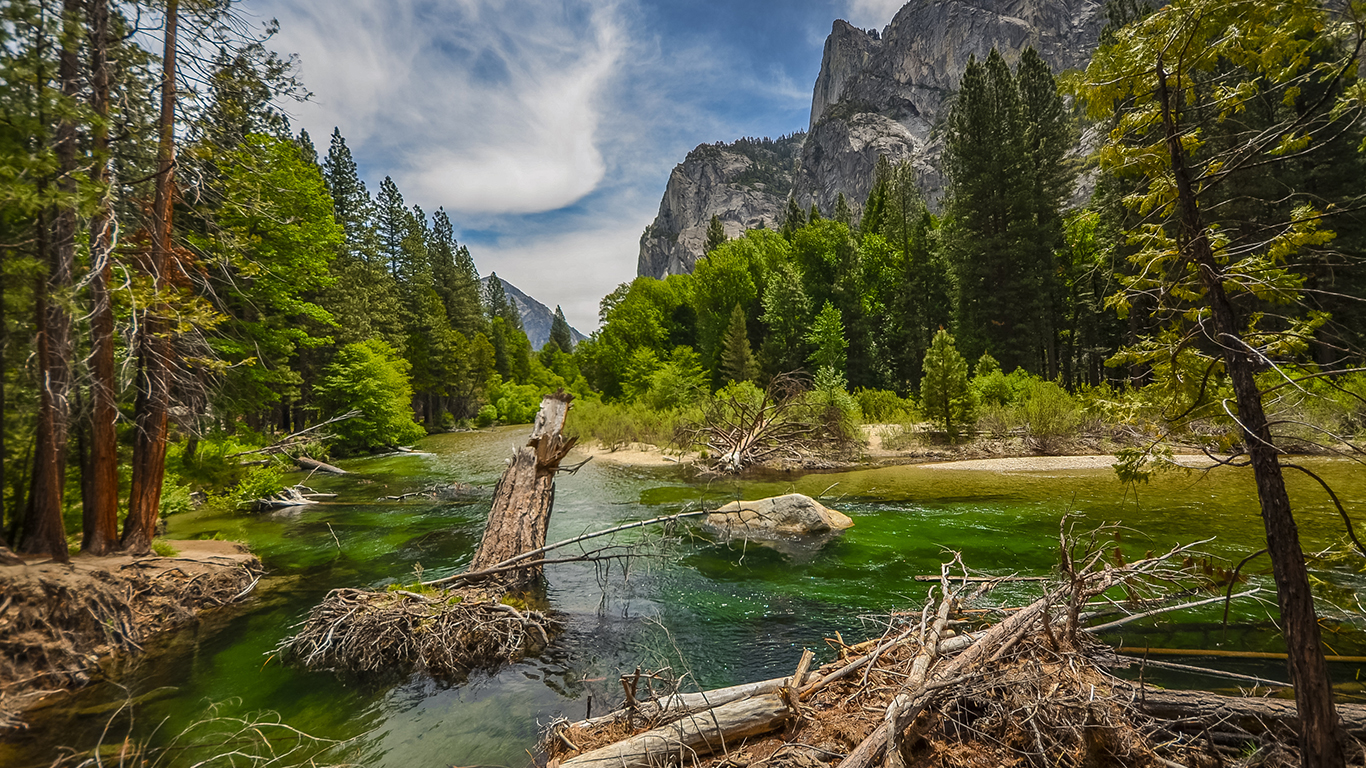
20. Kings Canyon National Park
> Total land area: 461,901 acres
> State: California
> Privately owned land: 55 acres
> 5-year change in tourism: +7%
Kings Canyon National Park, which adjoins Sequoia National Park, gained fame when conservationist John Muir visited the canyon in the late 19th century. Kings Canyon was formed by glacier activity.
[in-text-ad]
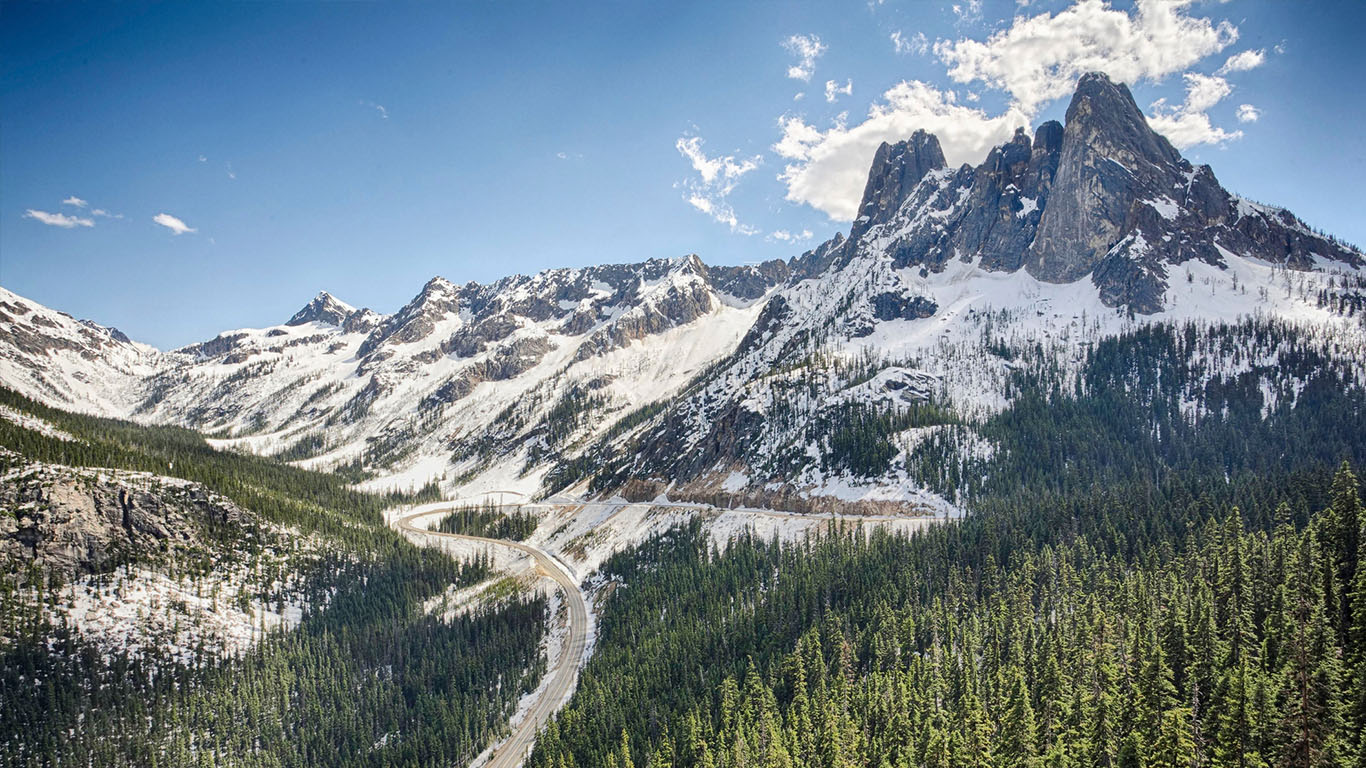
19. North Cascades National Park
> Total land area: 504,781 acres
> State: Washington
> Privately owned land: 127 acres
> 5-year change in tourism: +49%
North Cascades National Park is rich in history. Currently, 260 prehistoric sites have been identified, some of them dating back more than 8,500 years. The park and prehistoric sites are free to visitors. As you wander through the park, you may notice the red pictographs on the cliffs around Lake Chelan left by the Chelan people many years ago.
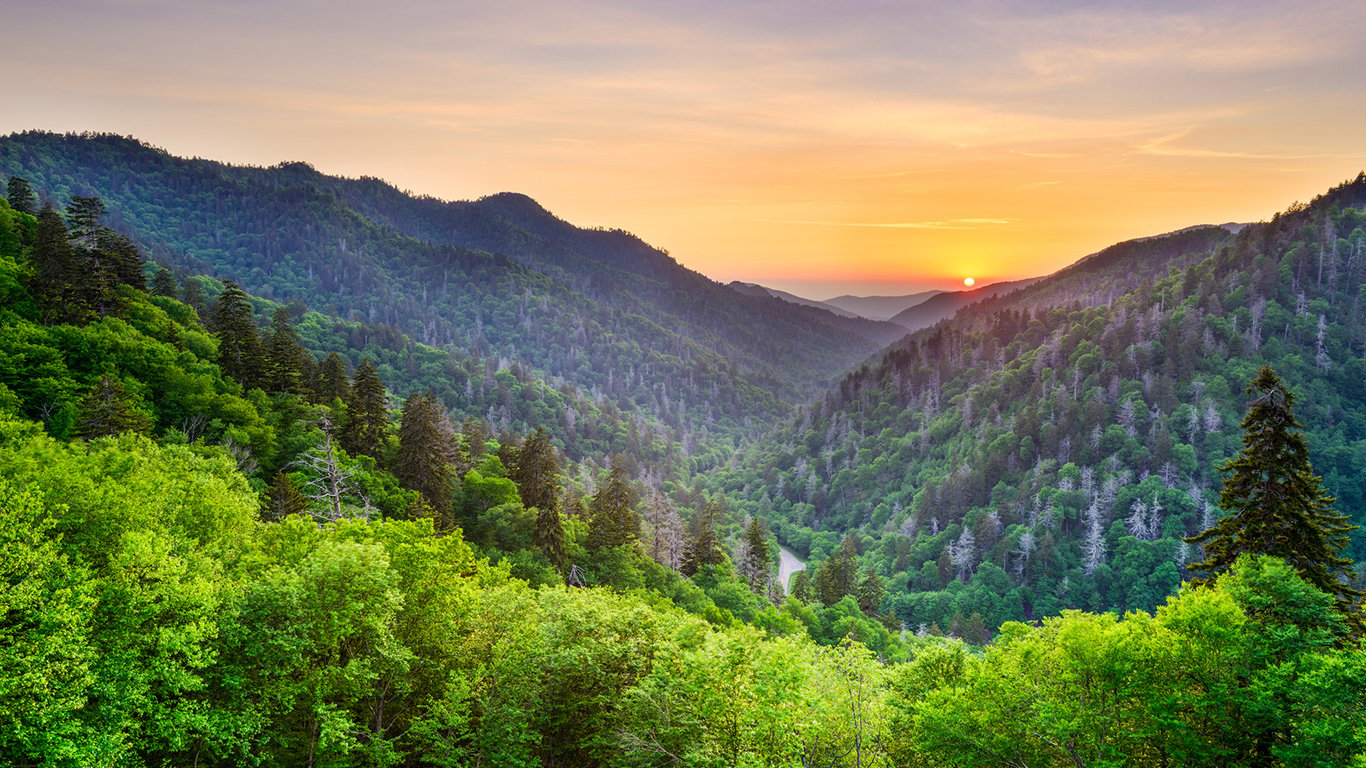
18. Great Smoky Mountains National Park
> Total land area: 522,427 acres
> State: Tennessee-North Carolina
> Privately owned land: 350 acres
> 5-year change in tourism: +26%
More than 11.3 million people came to explore the Great Smoky Mountains in 2016, making it America’s most visited national park. It’s not hard to see why, with more than 100 prominent cascades and waterfalls flowing throughout the forests and mountains.
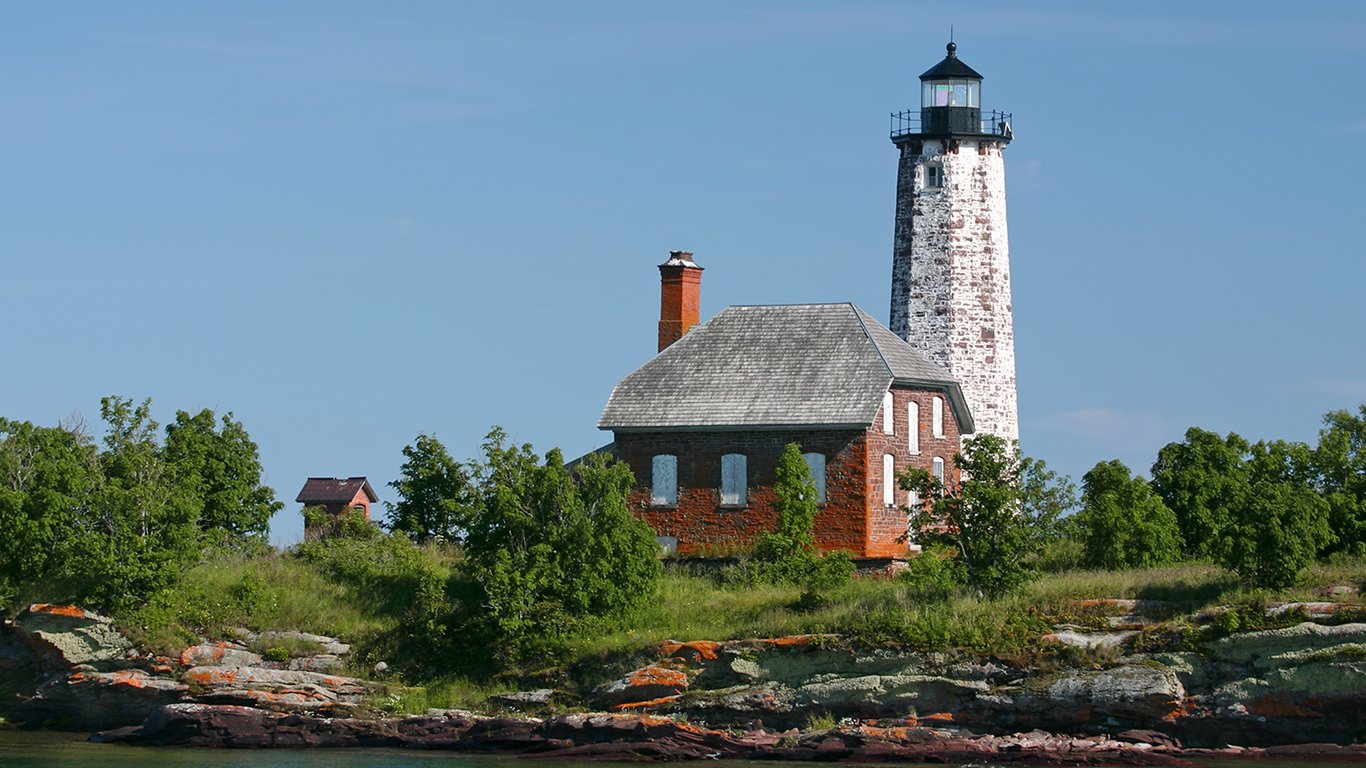
17. Isle Royale National Park
> Total land area: 571,790 acres
> State: Michigan
> Privately owned land: No private land
> 5-year change in tourism: +57%
An interactive mapping project at Isle Royale National Park, located on an island in Lake Superior, allows visitors to zoom into various historic features around the island. Visitors can explore lighthouses, fisheries, mining sites and Native American heritage.
[in-text-ad-2]
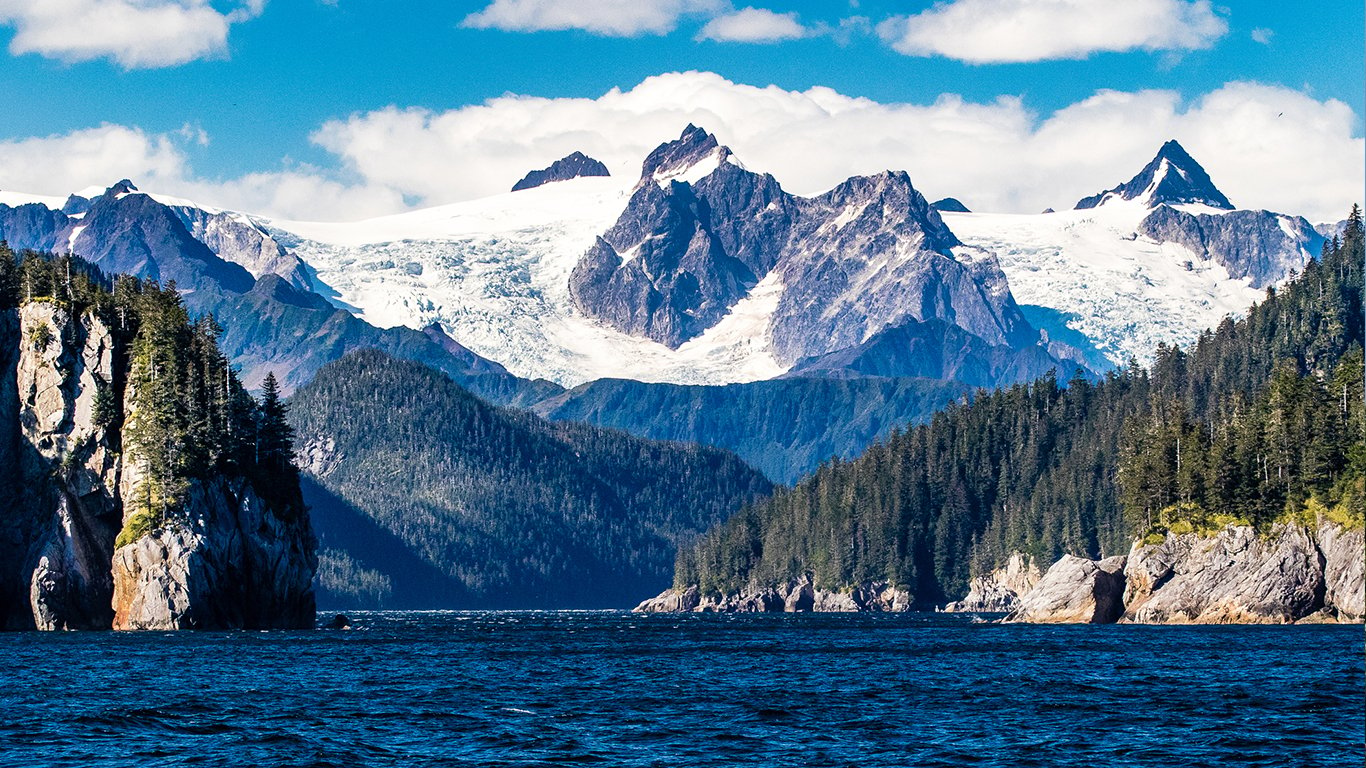
16. Kenai Fjords National Park
> Total land area: 669,650 acres
> State: Alaska
> Privately owned land: 47,218 acres
> 5-year change in tourism: -0.1%
This Alaska park gives tourists an opportunity to see something they can’t in warmer parts of the U.S. — glaciers. The Exit Glacier area shows how glaciers shape the landscape. Visitors can even hear the creaks and groans of a glacier sculpting the terrain.
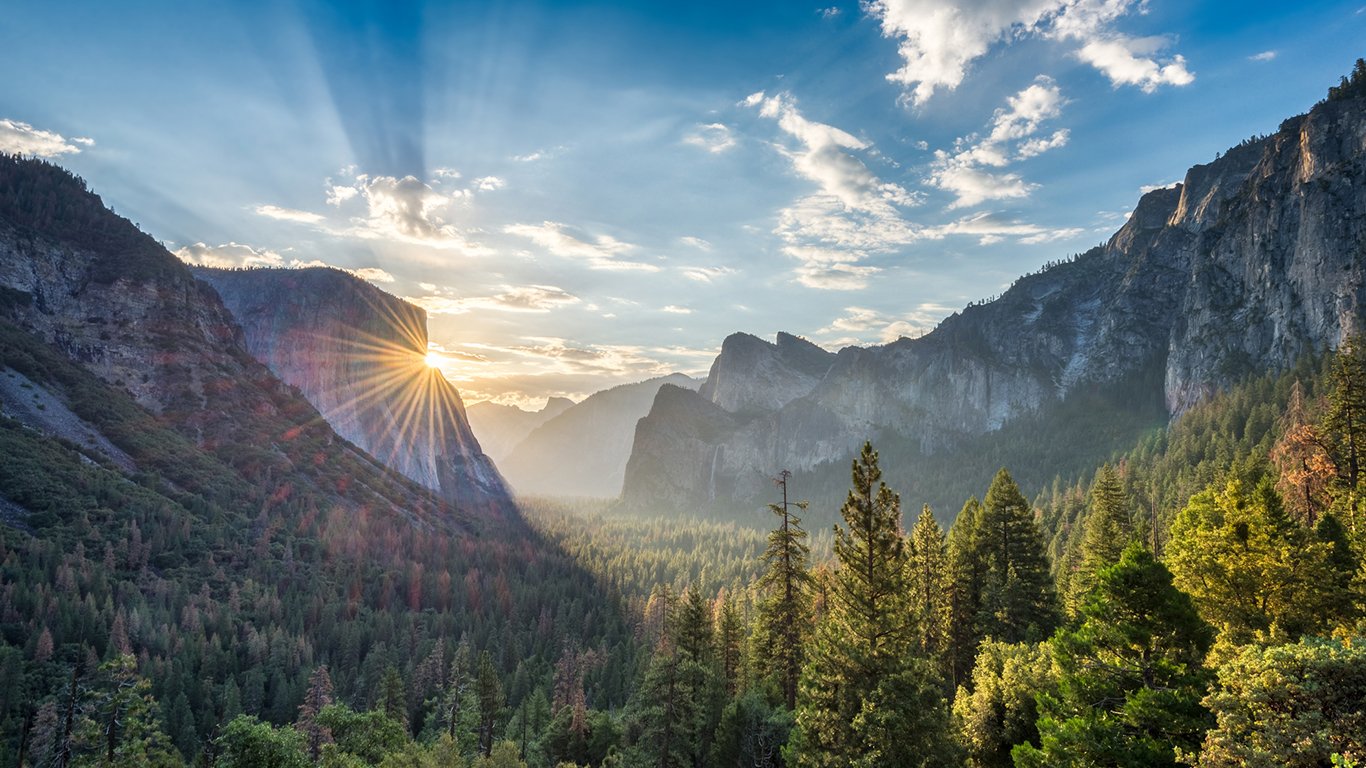
15. Yosemite National Park
> Total land area: 761,748 acres
> State: California
> Privately owned land: 225 acres
> 5-year change in tourism: +27%
What makes Yosemite National Park unique is not that it is covered by wilderness for over 95% of its territory, but that its landscape is dominated by granite. A popular destination for rock climbing, hiking and camping, adventure seekers may not know that “Yosemite” is a Miwok word for “those who kill” — a description of the feared tribes near the area.
[in-text-ad]
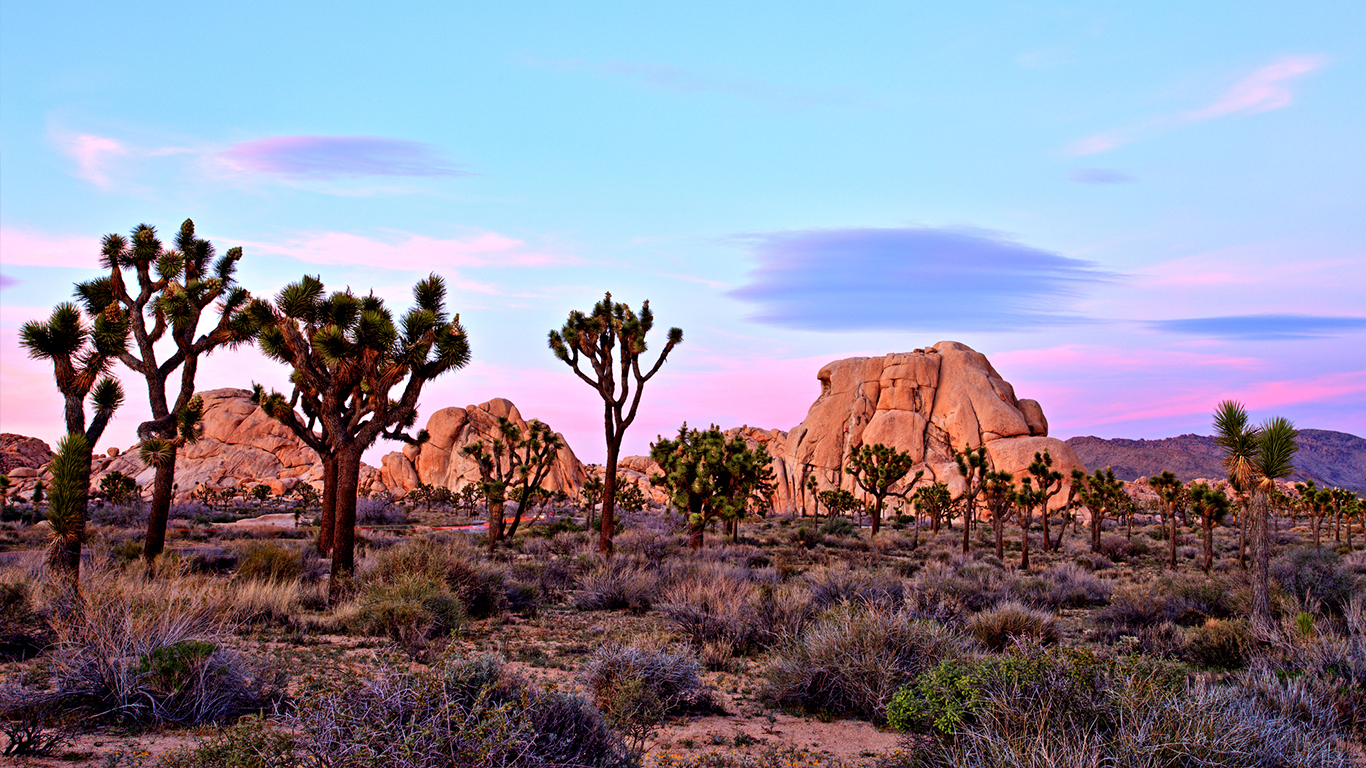
14. Joshua Tree National Park
> Total land area: 790,636 acres
> State: California
> Privately owned land: 8,874 acres,
> 5-year change in tourism: +79%
Joshua Tree National Park protects more than 700 archeological sites, 88 historic structures, 19 cultural landscapes, and houses 230,300 items in its museum collection. Joshua Tree owes its existence to the efforts of Minerva Hoyt, a Pasadena resident who fought to preserve the natural beauty of the region that was being ravaged by cacti poachers.
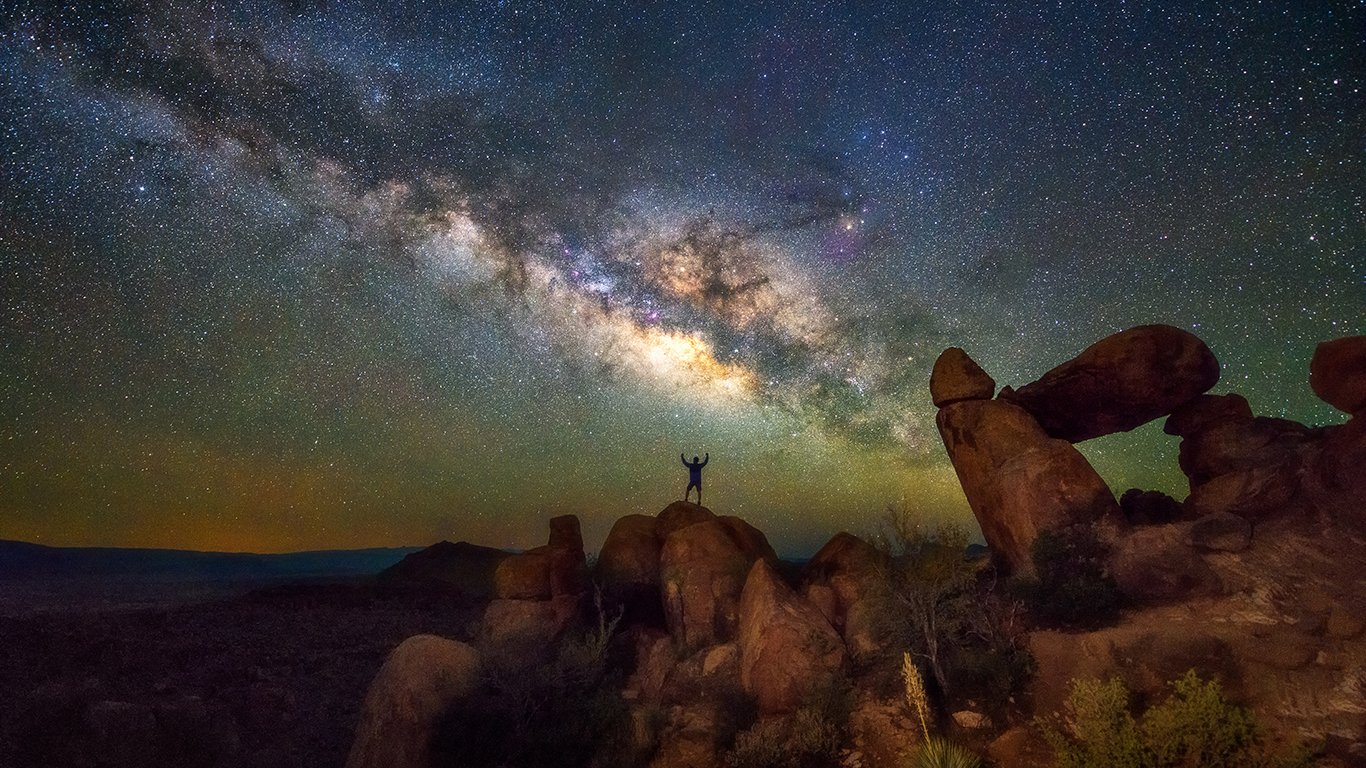
13. Big Bend National Park
> Total land area: 801,163 acres
> State: Texas
> Privately owned land: 23,283 acres
> 5-year change in tourism: +7%
The region where Big Bend National Park is may have been home to indigenous peoples for centuries, however, the area remained obscure to American settlers until the 1890s. Robert T. Hill led a six-man expedition to explore the Rio Grande, which runs through the Big Bend Region. Two years after his month-long trek, he published a book about the area, which may have helped the region become more popular.
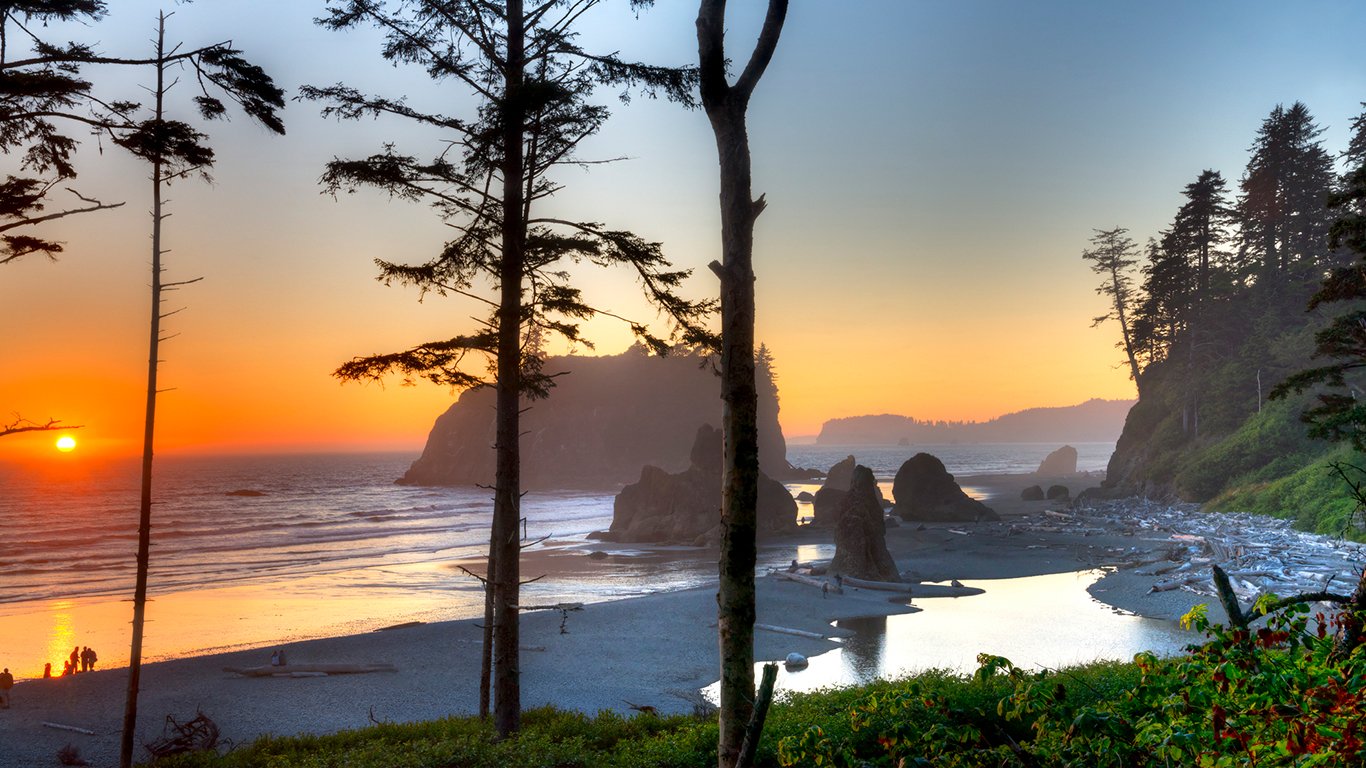
12. Olympic National Park
> Total land area: 922,650 acres
> State: Washington
> Privately owned land: 349 acres
> 5-year change in tourism: +14%
The Olympic National Park is divided into four separate eco-systems: the Pacific coastline, alpine areas, a rainforest on the west and forests on the east side. Because of the various regions available to visit, this national park became a UNESCO world heritage site in 1981.
[in-text-ad-2]

11. Glacier National Park
> Total land area: 1,013,129 acres
> State: Montana
> Privately owned land: 226 acres
> 5-year change in tourism: +59%
Glacier National Park, also called the “Crown of the Continent,’’ is the headwaters for streams that flow into the Pacific Ocean, the Gulf of Mexico, and Hudson Bay. There are 26 glaciers in the park, all of which are shrinking. In 1932, Waterton Lakes National Park in Alberta, Canada, combined with Glacier National Park to form the world’s first International Peace Park, which is situated on the border of the two countries and is a UNESCO site.
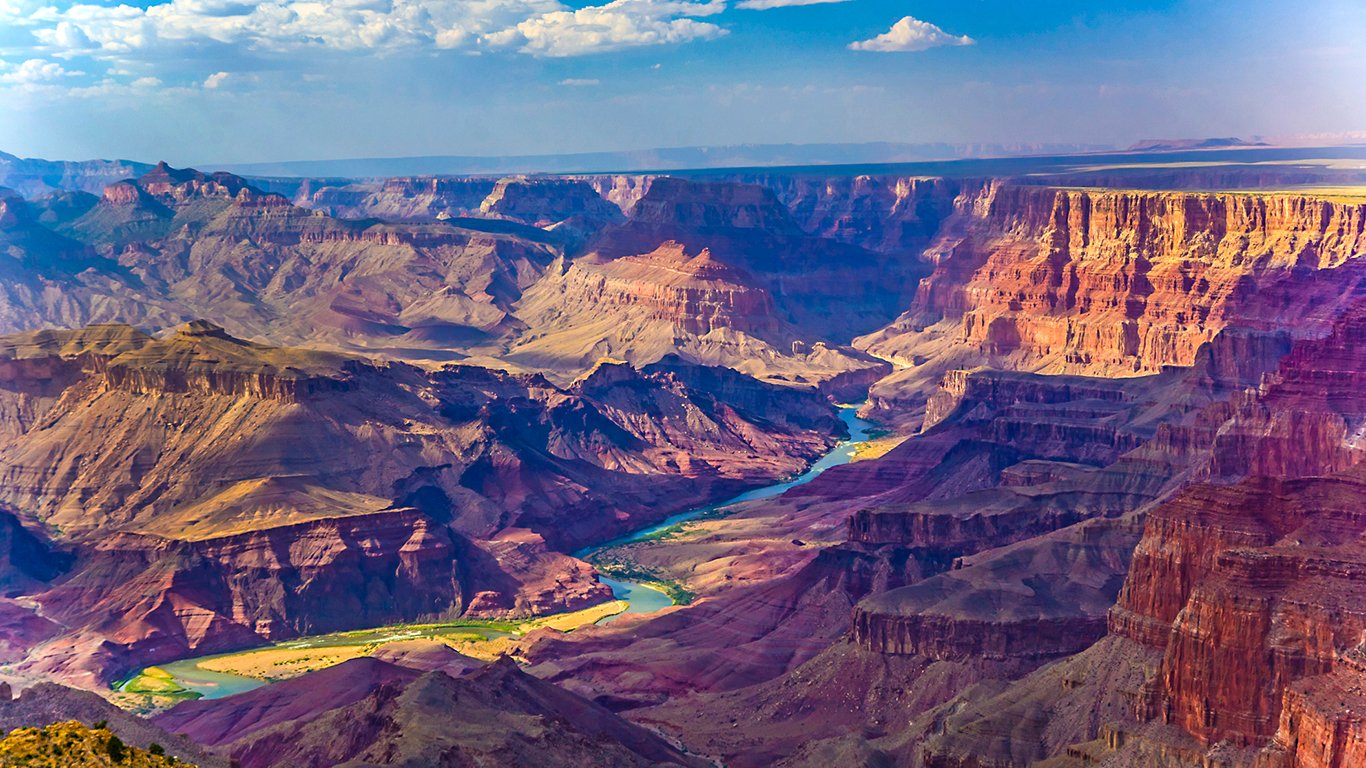
10. Grand Canyon National Park
> Total land area: 1,201,647 acres
> State: Arizona
> Privately owned land: 9,136 acres
> 5-year change in tourism: +39%
Of all the national parks in the country, the Grand Canyon may be the most famous. The Grand Canyon was first granted federal protection in 1893, but was not designated a national park until 1919. In that year 44,173 people visited the park. Nearly 5 million people travel to the Grand Canyon each year.
[in-text-ad]
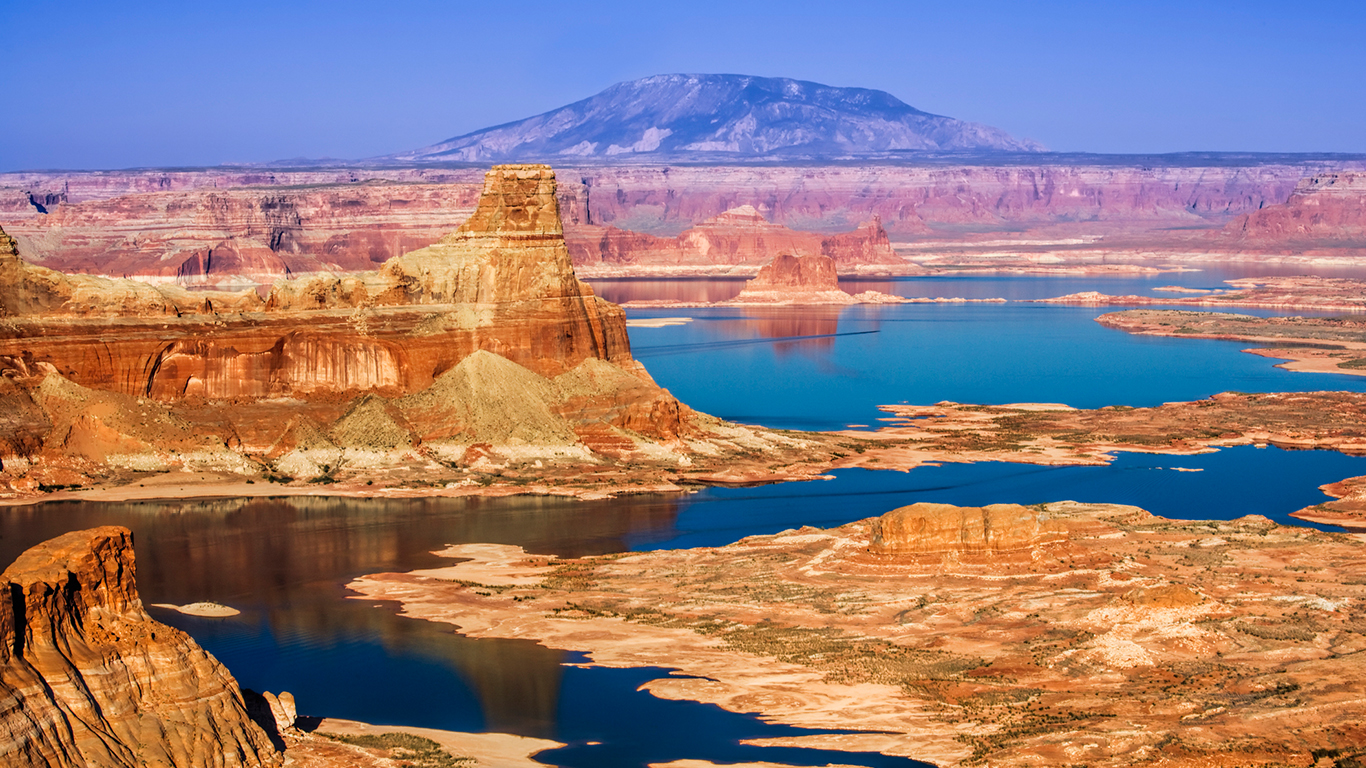
9. Glen Canyon National Recreation Area
> Total land area: 1,254,117 acres
> State: Arizona-Utah
> Privately owned land: No private land
> 5-year change in tourism: +43%
Established in 1972, this national recreation area was created for the purpose of leisure rather than conservation. As a result, there are various ways to get there — even by commercial airline. Once there, visitors can launch their boats, fish, swim or camp on the beach of Lake Powell.
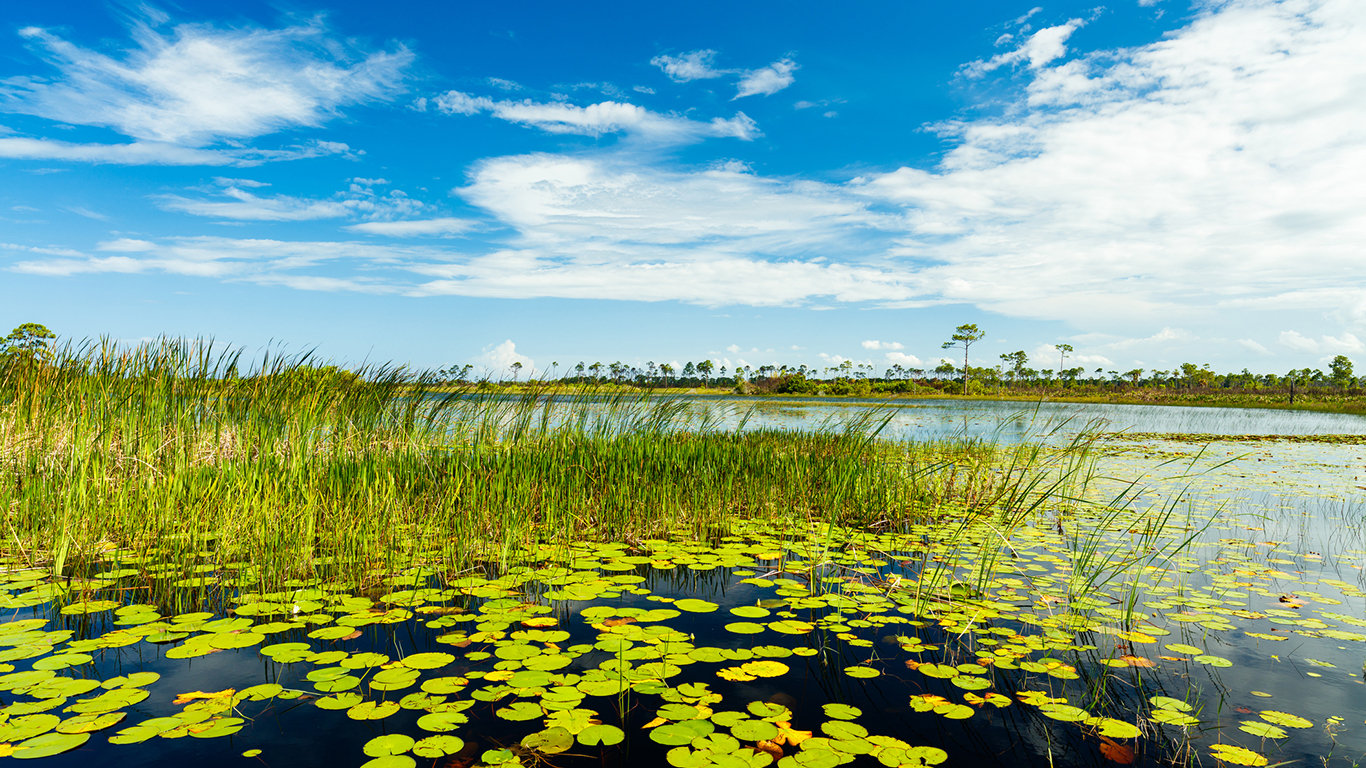
8. Everglades National Park
> Total land area: 1,400,539 acres
> State: Florida
> Privately owned land: 286 acres
> 5-year change in tourism: -0.4%
The Everglades National Park is the largest subtropical wilderness in the U.S. The park is home to rare and endangered species, such as the manatee, American crocodile, and the Florida panther. In recent years, the Burmese python, one of the largest snake species on earth, has invaded the Everglades and disrupted its ecosystem by preying on birds and smaller animals.
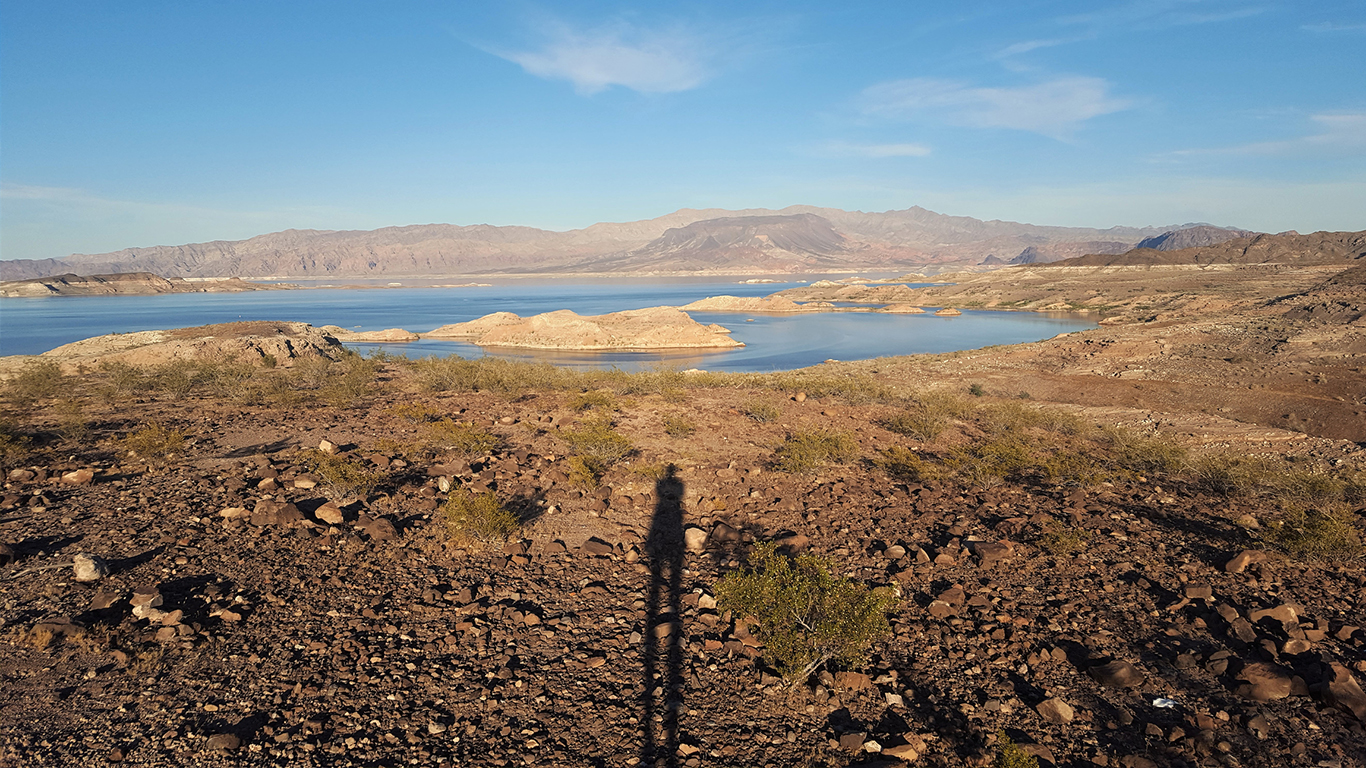
7. Lake Mead National Recreation Area
> Total land area: 1,495,806 acres
> State: Arizona-Nevada
> Privately owned land: 22,368 acres
> 5-year change in tourism: 12%
Lake Mead is one of 12 national recreation areas centered on large reservoirs. Not surprisingly, Lake Mead is a great place to engage in water activities, such as sport fishing, boating, kayaking, canoeing, and scuba diving. A rare fish species called razorback suckers can be found in both Lake Mead and Lake Mohave, and each year biologists make efforts to save newly hatched razorback suckers from predators.
[in-text-ad-2]
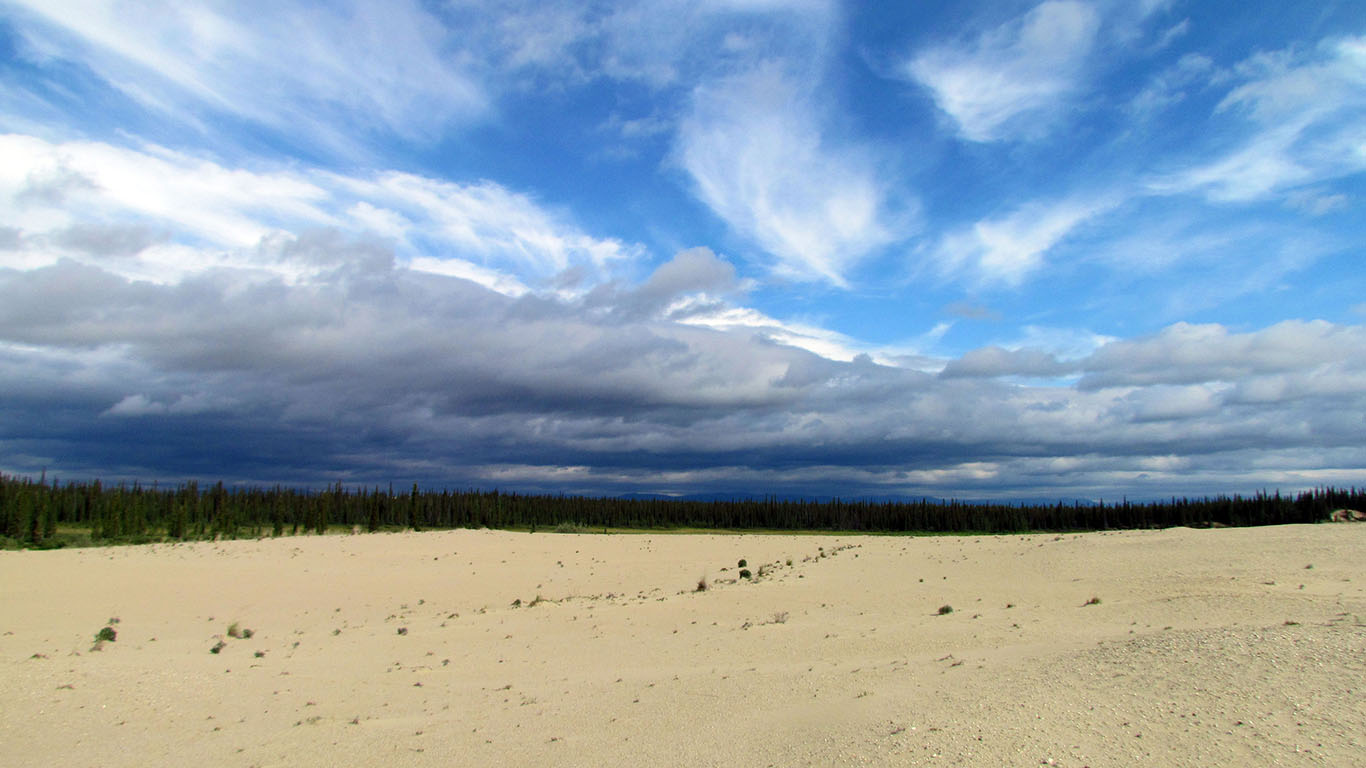
6. Kobuk Valley National Park
> Total land area: 1,750,716 acres
> State: Alaska
> Privately owned land: 35,492 acres
> 5-year change in tourism: 35%
Tourists looking for sand dunes don’t need to leave the U.S. In fact, the Great Kobuk Sand Dunes are one of the biggest attractions of Kobuk Valley National Park. Hikers can also observe the caribou during their spring and fall migration.
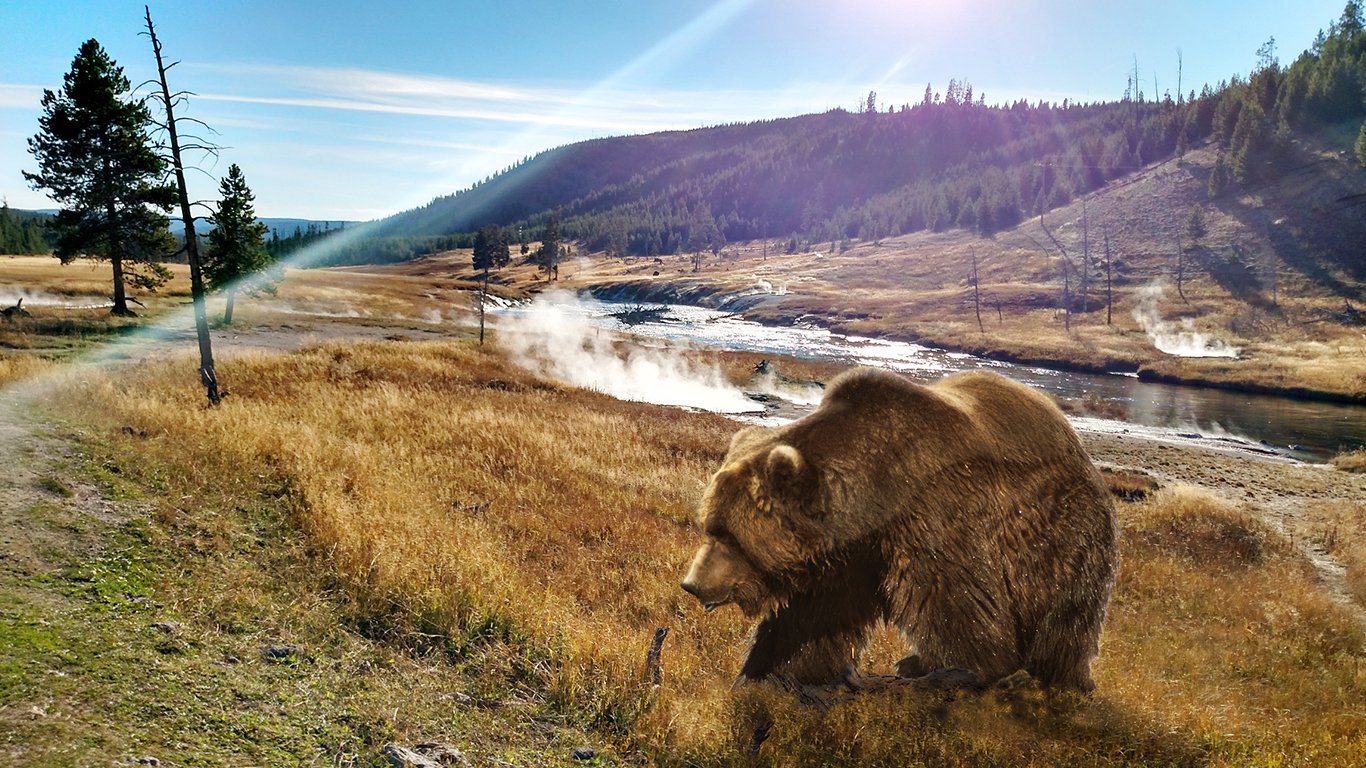
5. Yellowstone National Park
> Total land area: 2,219,791 acres
> State: Idaho-Montana-Wyoming
> Privately owned land: 0.2 acres
> 5-year change in tourism: +25%
As legend has it, a group of explorers passed through the region in 1870 and claimed this “land of fire and ice and wild animals needed to be preserved.” It was at this point that the idea of a national park was born. President Ulysses S. Grant signed the Yellowstone National Park Protection Act into 1872, making Yellowstone the world’s first national park. Yellowstone is the home of the famous geyser Old Faithful.
[in-text-ad]
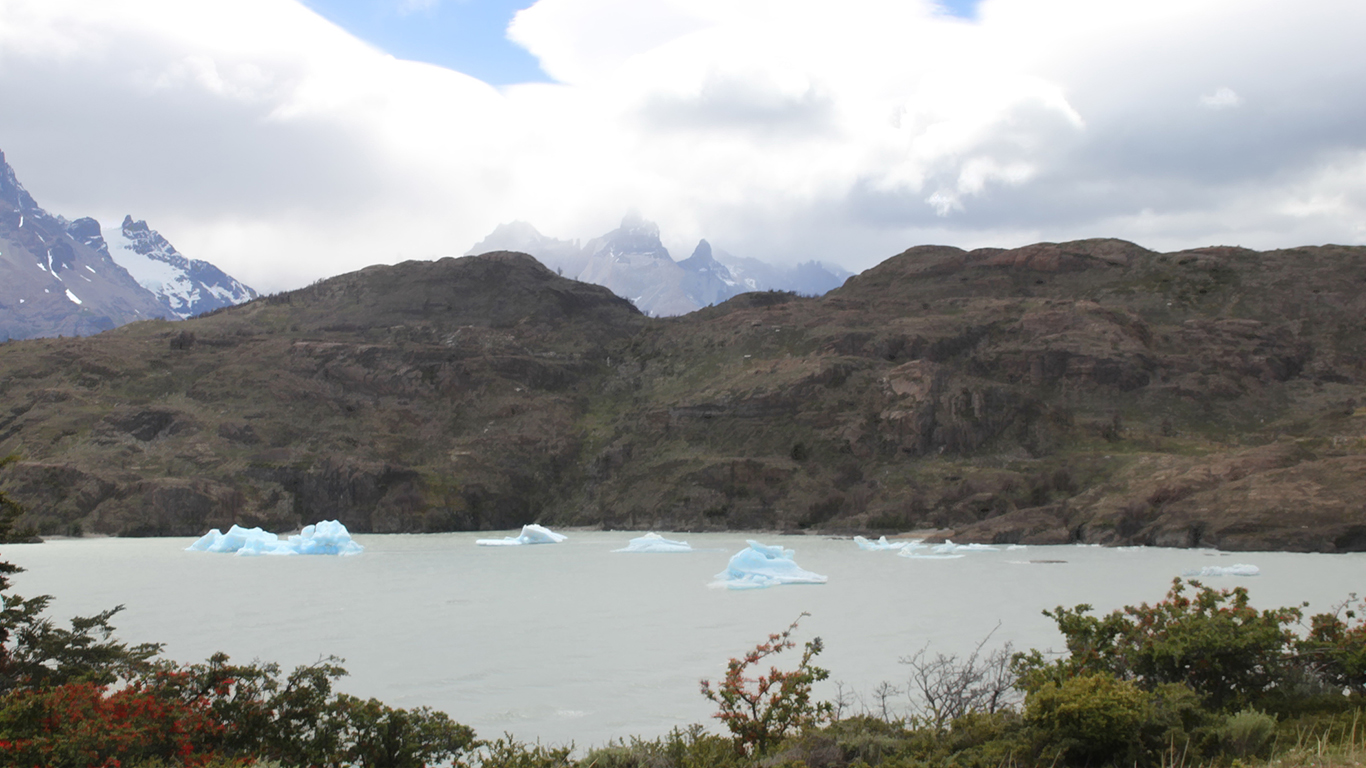
4. Glacier Bay National Park and Preserve
> Total land area: 3,223,383 acres
> State: Alaska
> Privately owned land: 1,099 acres
> 5-year change in tourism: +59%
Glacier Bay National Park and Preserve covers 3.3 million acres of mountains, glaciers, temperate rainforest, coastlines and fjords. The park is part of a 25-million acre World Heritage Site that is visited by thousands of tourists on cruise ships and Glacier Bay is one of the world’s largest international protected areas.
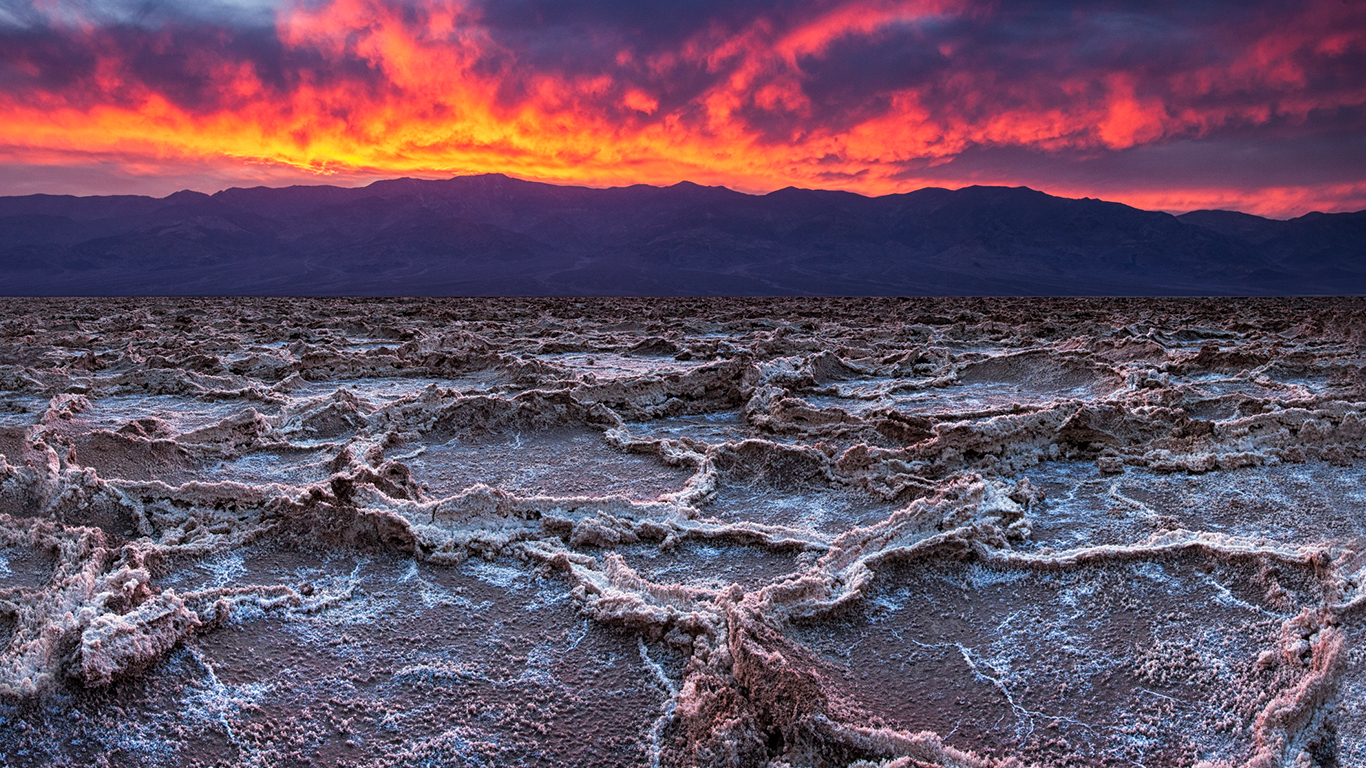
3. Death Valley National Park
> Total land area: 3,373,063 acres
> State: California-Nevada
> Privately owned land: 9,716 acres
> 5-year change in tourism: +37%
The largest national park in the continental U.S. is also one of the lowest points on earth. Despite its gloomy name, given by pioneers who were lost in the valley during the California Gold Rush, an indigenous population has lived in what is now the park for around 7,000 years.

2. Denali National Park
> Total land area: 4,740,911 acres
> State: Alaska
> Privately owned land: 2,598 acres
> 5-year change in tourism: +44%
Denali National Park, home to the tallest mountain in North America, celebrates its 100th birthday this year. If you’re travelling through the park by car, you won’t have to worry about getting lost. There is only one road, it’s 92 miles long, and the park has just one entrance.
[in-text-ad-2]
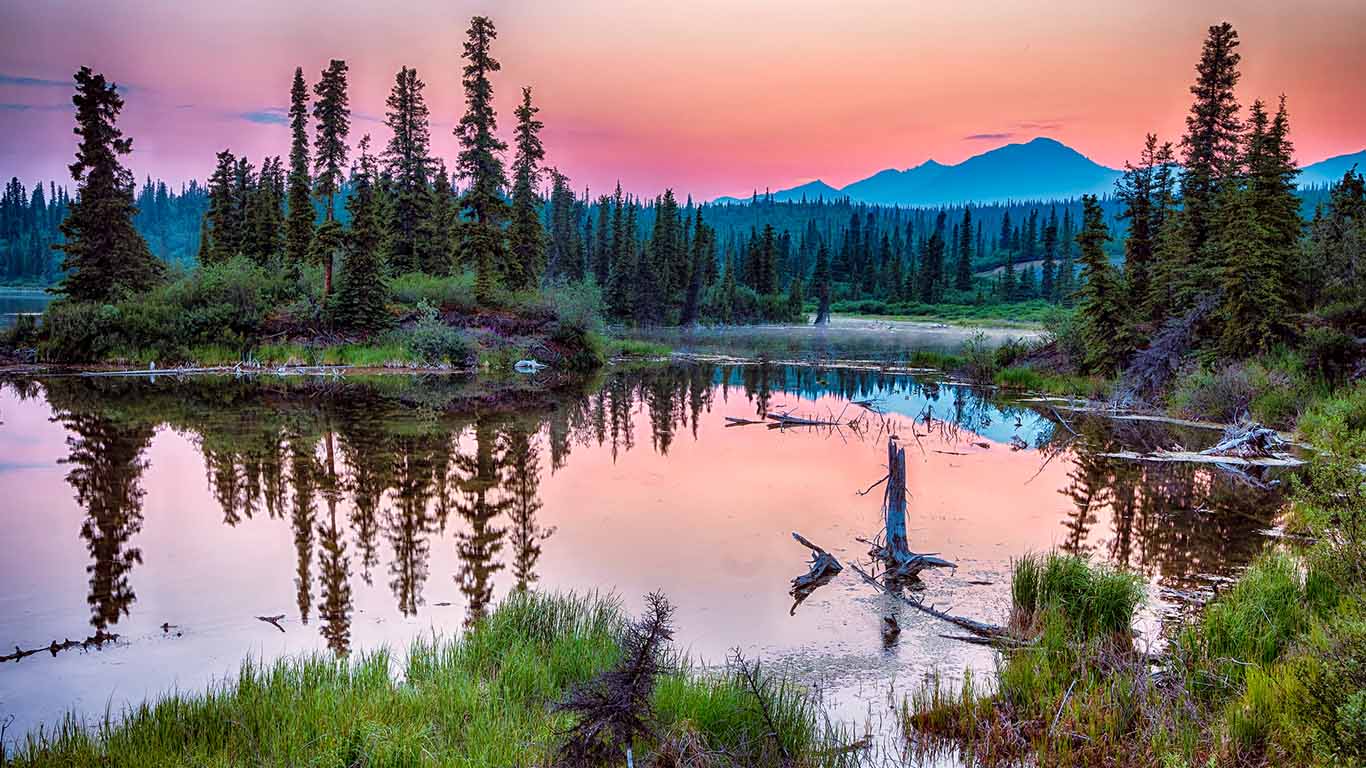
1. Wrangell-St. Elias National Park
> Total land area: 8,323,146 acres
> State: Alaska
> Privately owned land: 348,872 acres
> 5-year change in tourism: +21%
Wrangell St. Elias National Park is America’s largest national park, rising from the Pacific Ocean up to 18,008-foot Mount St. Elias. When combined with the land from the preserve, the park has 13.2 million acres — the same size as Yellowstone National Park, Yosemite National Park, and Switzerland combined. Four major mountain ranges meet in the park, which include nine of the 16 highest peaks in the U.S. Near the coast is North America’s largest sub-polar icefield, Bagley Icefield.
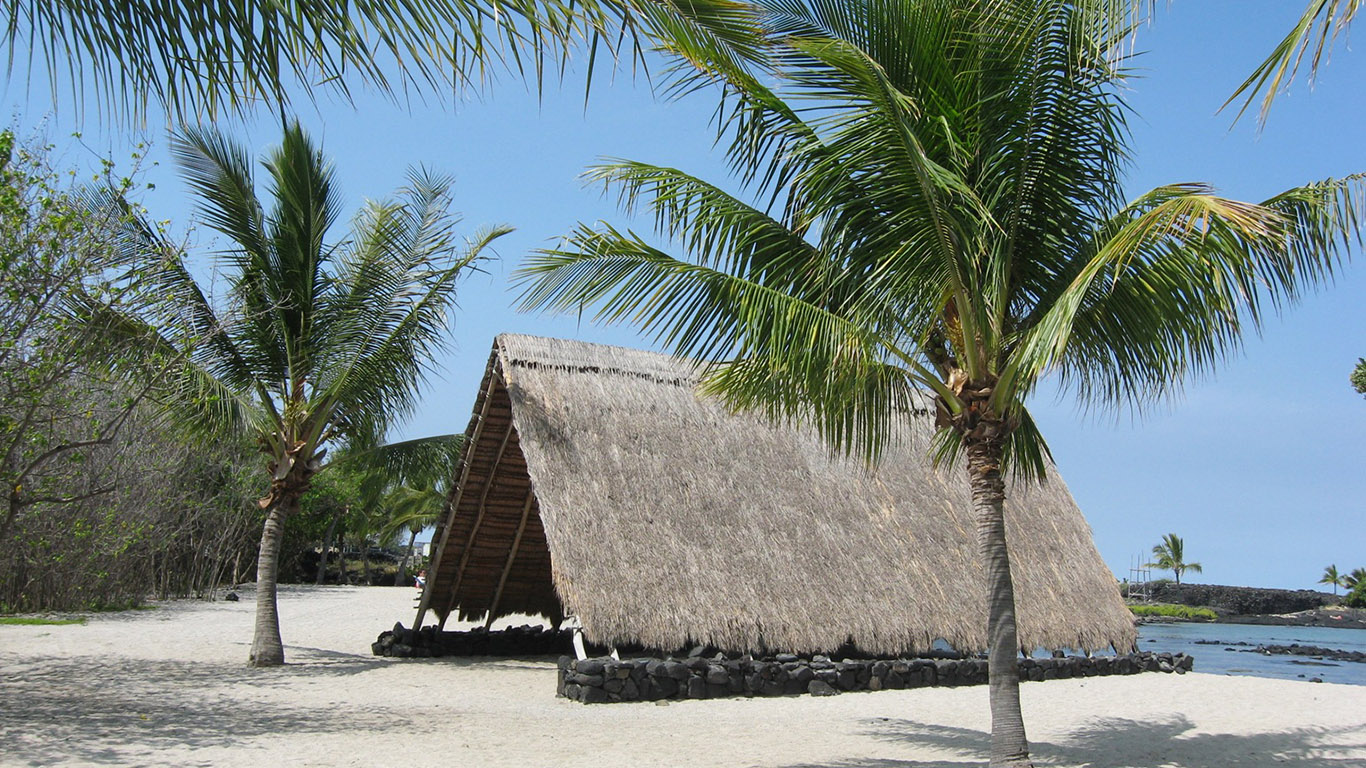
25. Kaloko-Honokohau National Historical Park
> Total land area: 1,163 acres
> State: Hawaii
> Privately owned land: 28 acres
> 5-year change in tourism: +14%
Picturing the park’s translated Hawaiian name of fishpond and village is the best way to imagine this historical place. Hiking through the park established in 1978, you will reach Kaloko Fishpond – a portrayal of the advanced engineering feats of ancient Hawaiians.
[in-text-ad]
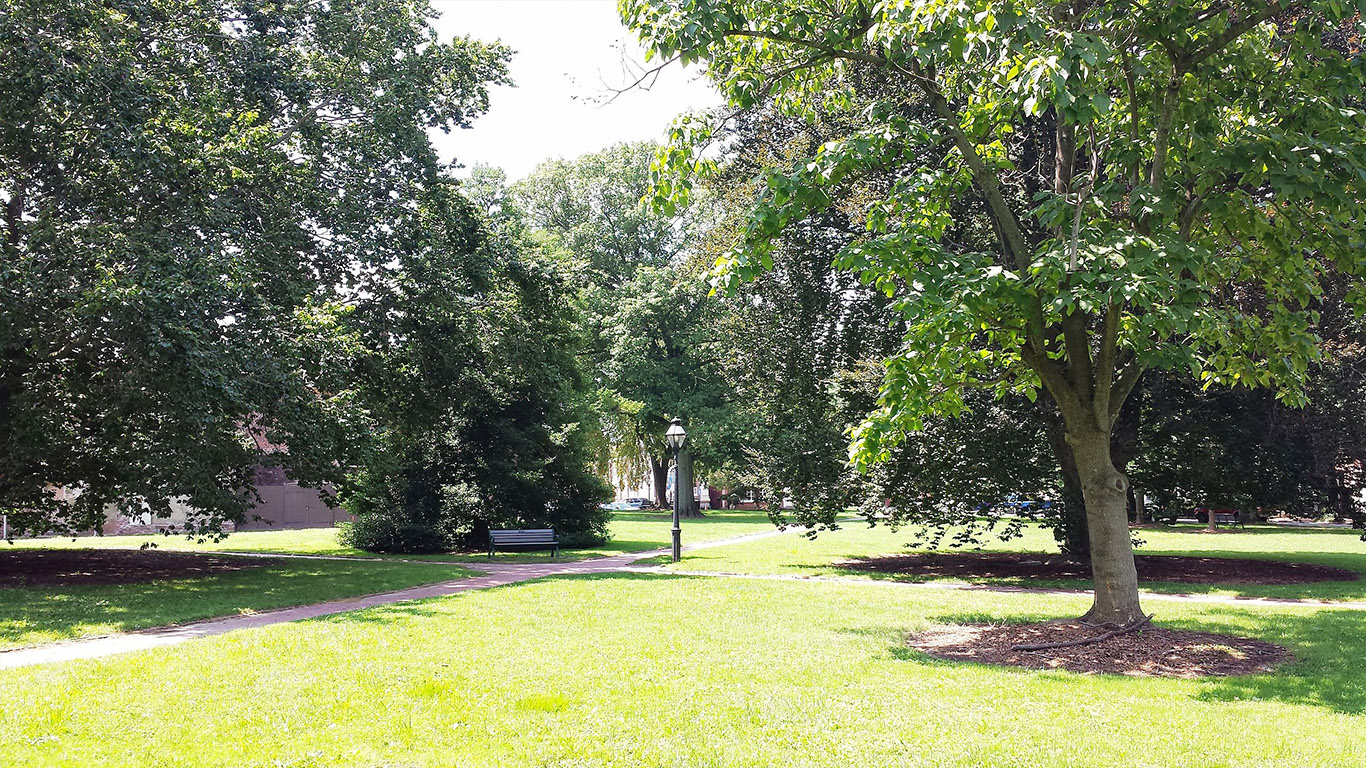
24. First State National Historical Park
> Total land area: 1,115 acres
> State: Delaware-Pennsylvania
> Privately owned land: 42 acres
> 5-year change in tourism: -36%
Created as a national monument by President Obama, Congress later designated the area as a National Historical Park in 2014. Delaware was the first state to ratify the Constitution and, as such, the park commemorates the early colonial history of Delaware and its role in establishing the country.
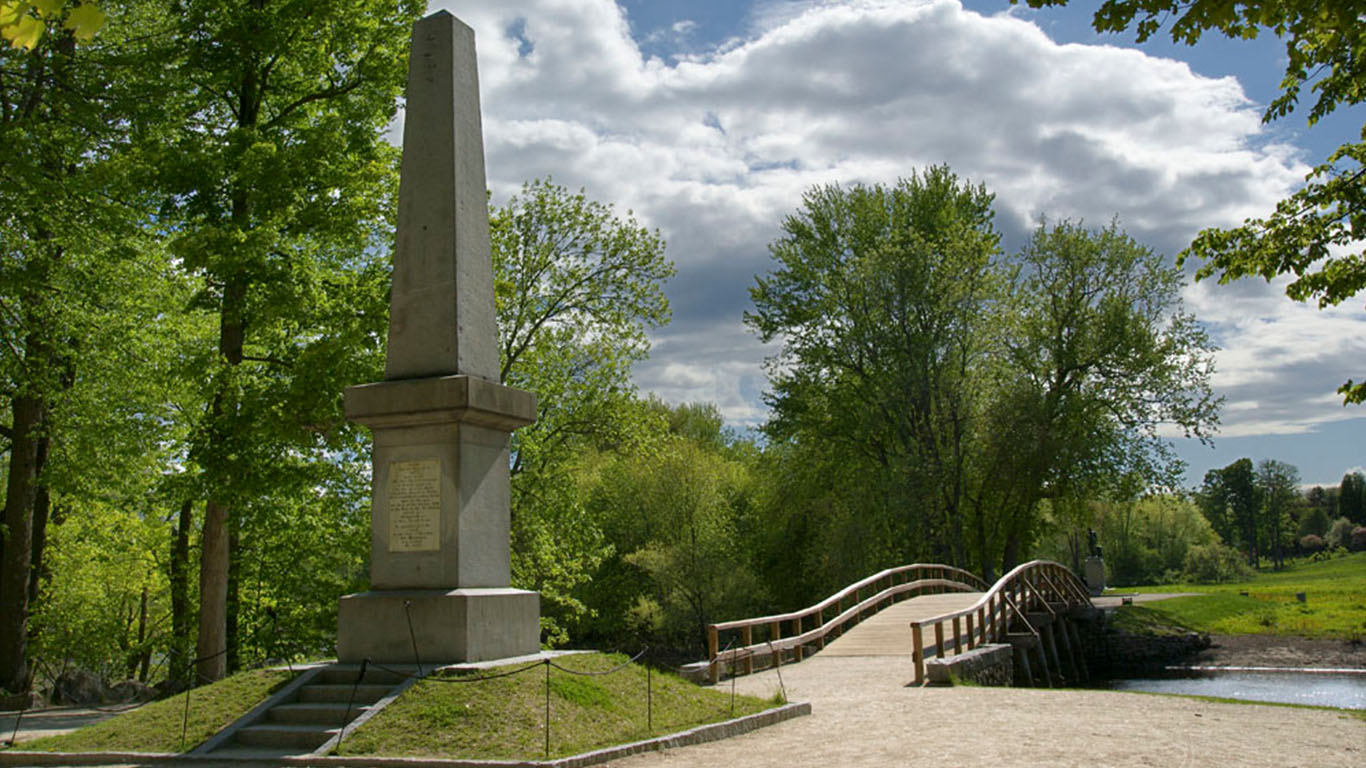
23. Minute Man National Historical Park
> Total land area: 1,028 acres
> State: Massachusetts
> Privately owned land: 100 acres
> 5-year change in tourism: +5%
This park in Concord, Massachusetts, was established in 1959 to commemorate the opening battle of the American Revolutionary War. A well-known tourist destination is the The Wayside – a small house where American writers Louisa May Alcott, Nathaniel Hawthorne and Harriet Lothrop once lived.

22. Salt River Bay National Historical Park
> Total land area: 989 acres
> State: Virgin Islands
> Privately owned land: 105 acres
> 5-year change in tourism: +580%
Located on St. Croix in the U.S. Virgin Islands, this historical park documents the battle between early indigenous settlements and European powers. The park has witnessed a nearly 600% increase in tourism in the last five years and requires no entrance fee to get in.
[in-text-ad-2]
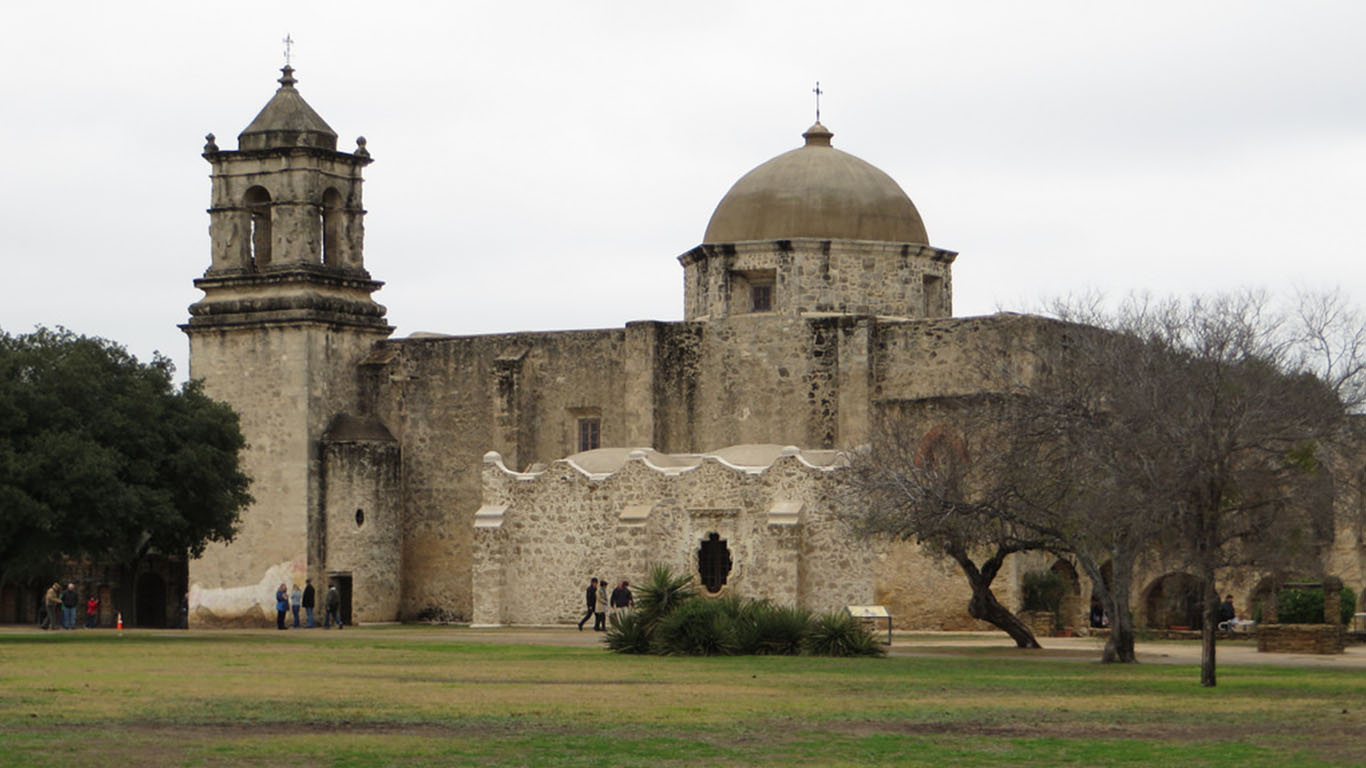
21. San Antonio Missions National Historical Park
> Total land area: 948 acres
> State: Texas
> Privately owned land: 147 acres
> 5-year change in tourism: +139%
The San Antonio Missions tell the stories of those who came to the Spanish missions to live in the 1700s. In 1978, four of the Spanish missions in San Antonio became a part of the national historical park system. The park informs visitors about the most important factors of the missions: the people, the church, farming, ranching, and caminos reals (historic roads).
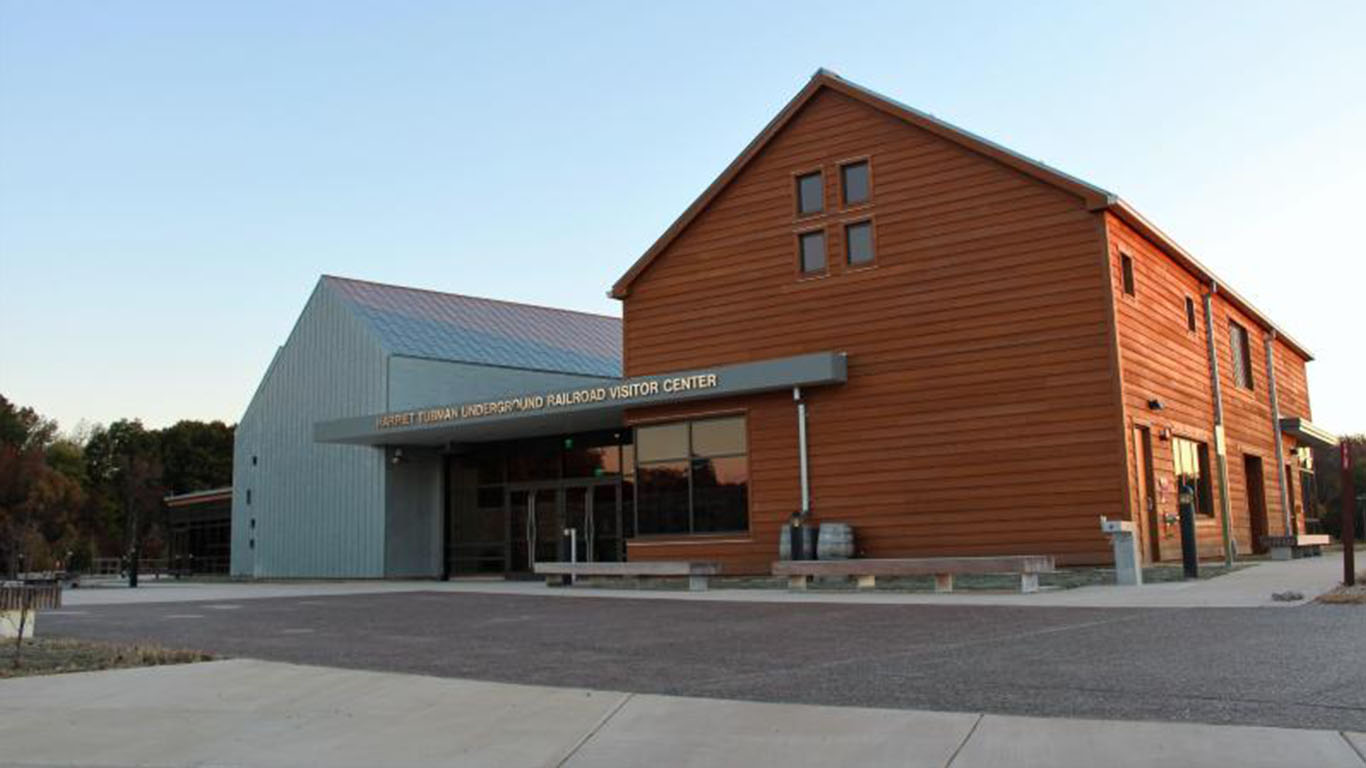
20. Harriet Tubman Underground Railroad National Historical Park
> Total land area: 480 acres
> State: Maryland
> Privately owned land: No private land
> 5-year change in tourism: +85%
Harriet Tubman was a hero to African Americans during the Civil War. Tubman assisted in the escape of over 70 slaves as a “conductor” in the Underground Railroad. In 2013, President Obama created the Harriet Tubman Underground Railroad National Monument, which would later have a portion converted to a national historical park in 2014.
[in-text-ad]
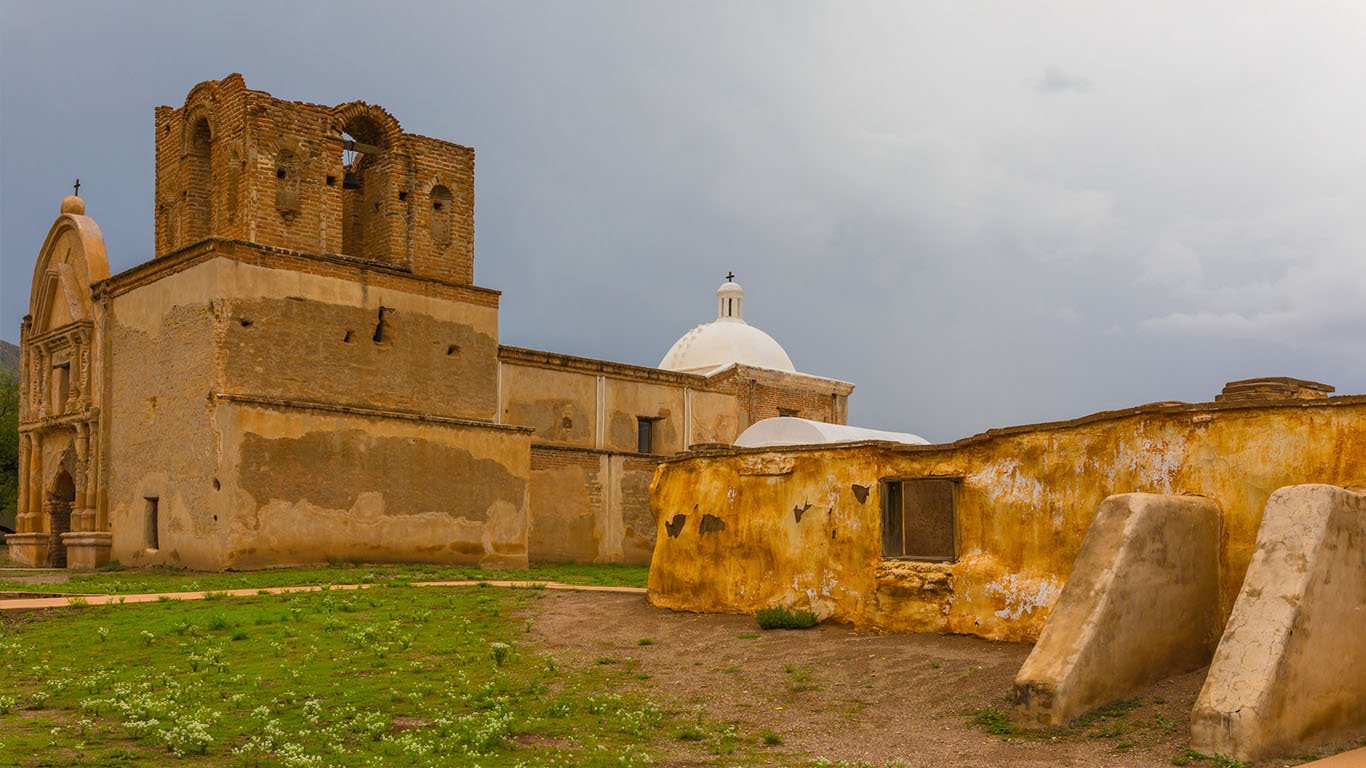
19. Tumacacori National Historical Park
> Total land area: 360 acres
> State: Arizona
> Privately owned land: 02 acres
> 5-year change in tourism: +25%
The Jesuits were a powerful social and economic presence in the region, and one of them, Eusebio Francisco Kino, founded the San Cayetano de Tumacácori Mission on the Santa Cruz River’s east bank in January 1691. The Tumacácori site became part of the United States in 1853 and it would become a national historical park in 1990.
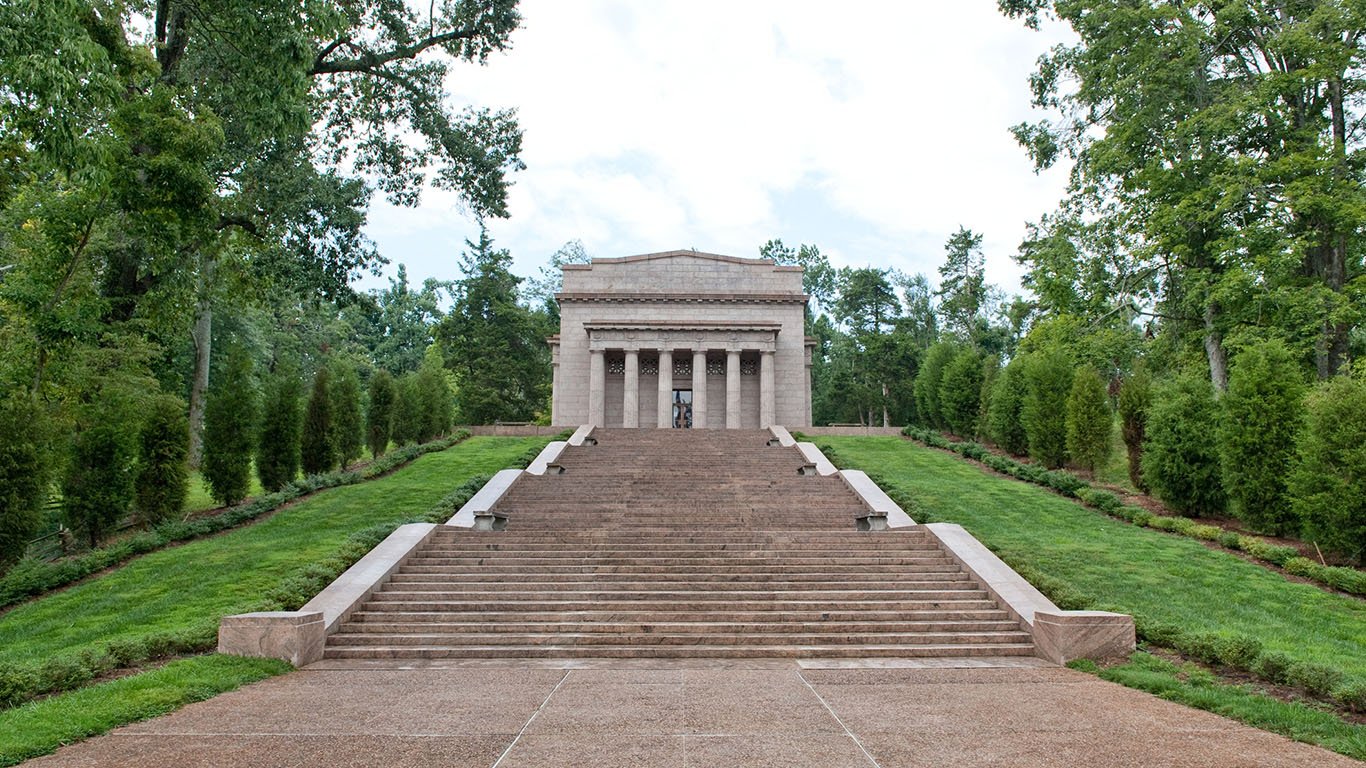
18. Abraham Lincoln Birthplace National Historical Park
> Total land area: 345 acres
> State: Kentucky
> Privately owned land: No private land
> 5-year change in tourism: +54%
For more than 100 years, visitors have paid homage to the humble birthplace of Abraham Lincoln, the 16th president of the United States. Tourists can visit the first memorial dedicated to the president and see the Sinking Spring — the water source used by the Lincoln family.
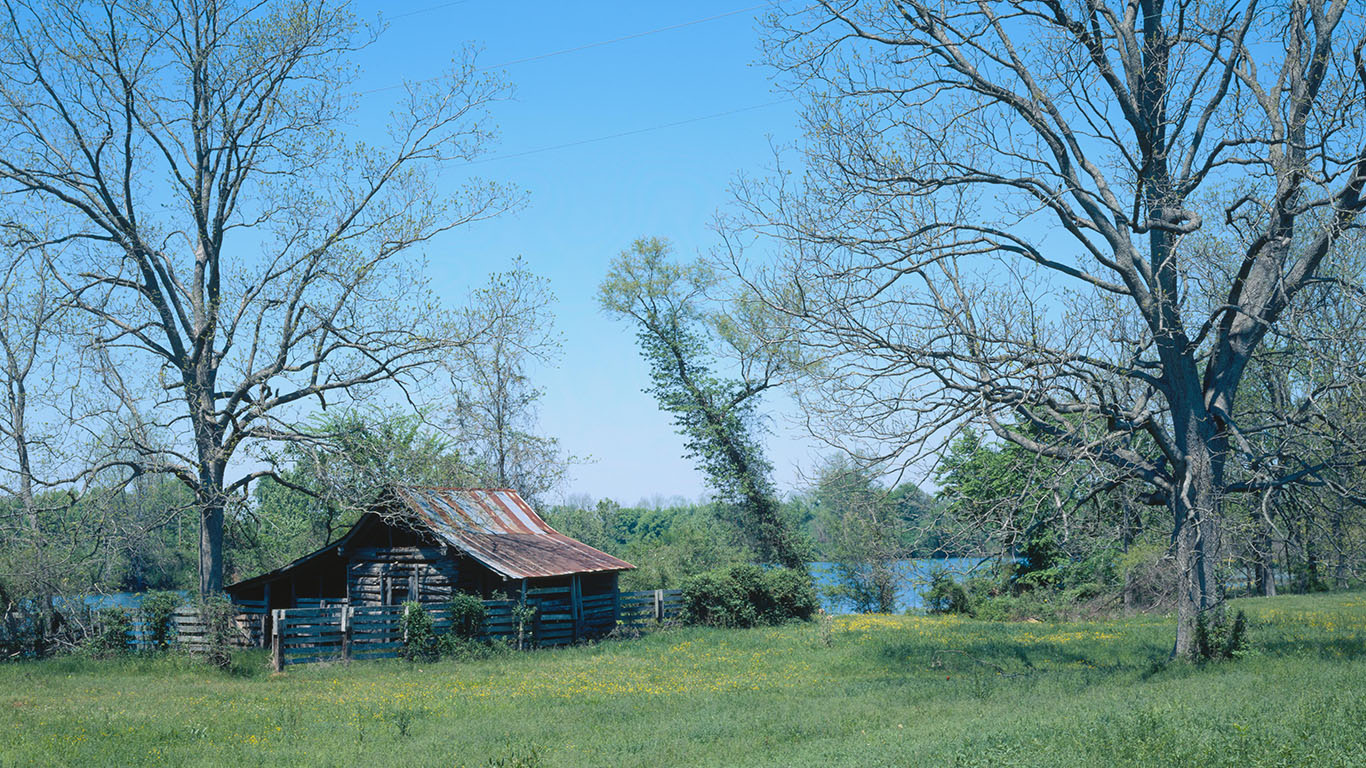
17. Cane River Creole National Historical Park
> Total land area: 206 acres
> State: Louisiana
> Privately owned land: 138 acres
> 5-year change in tourism: -0.5%
Cane River Creole National Historical Park is the site of the Oakland and Magnolia plantations, where slaves and later sharecroppers worked the land before and after the Civil War. Visitors can tour the Oakland Plantation daily and the Magnolia Plantation on weekends. They can also learn about Creole history and culture at the park.
[in-text-ad-2]
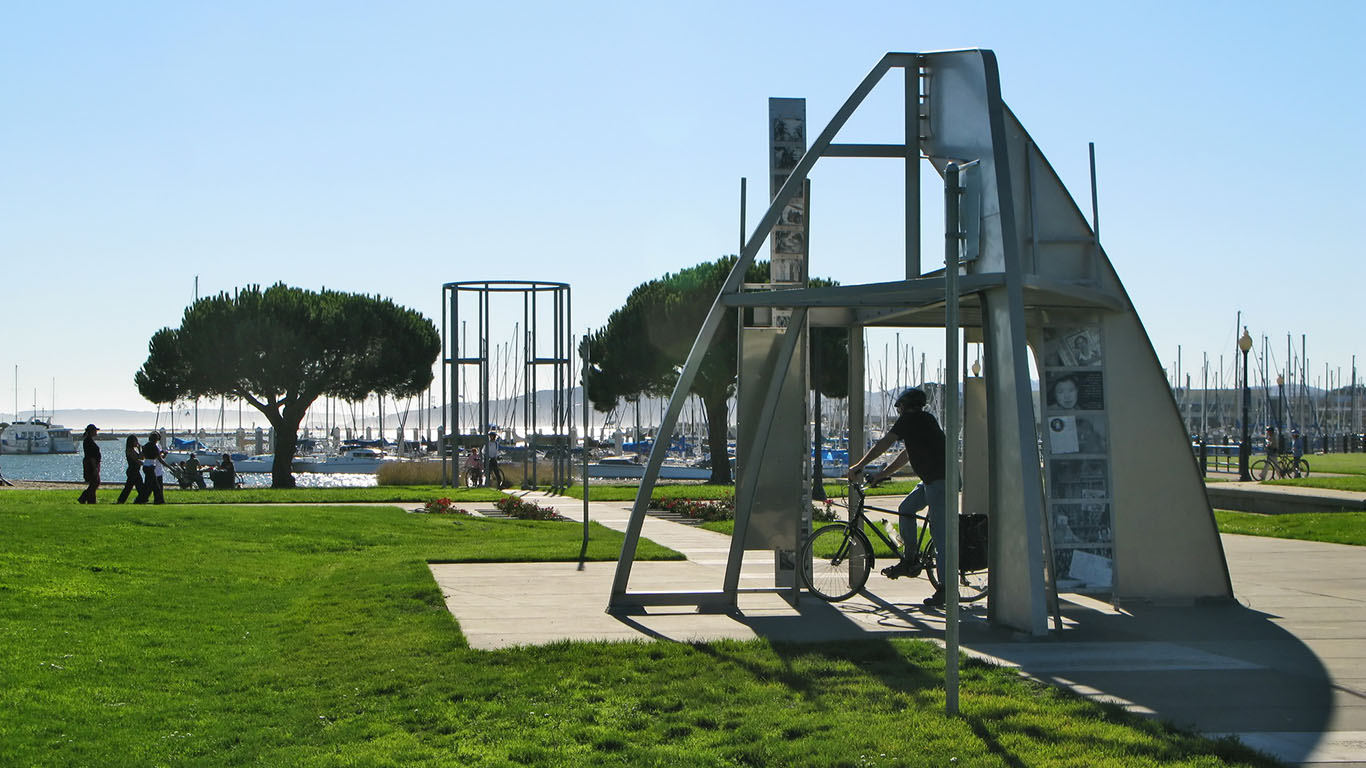
16. Rosie the Riveter National Historical Park
> Total land area: 145 acres
> State: California
> Privately owned land: No private land
> 5-year change in tourism: +27%
With over 16 million Americans serving overseas in World War II, an employment gap needed to be filled back home. Women helped the war effort locally by joining the workforce and taking over jobs the men had left behind, including as shipyard workers. Visitors can board (for no charge) the SS Red Oak Victory Ship, the last surviving ship built in Kaiser Shipyards.
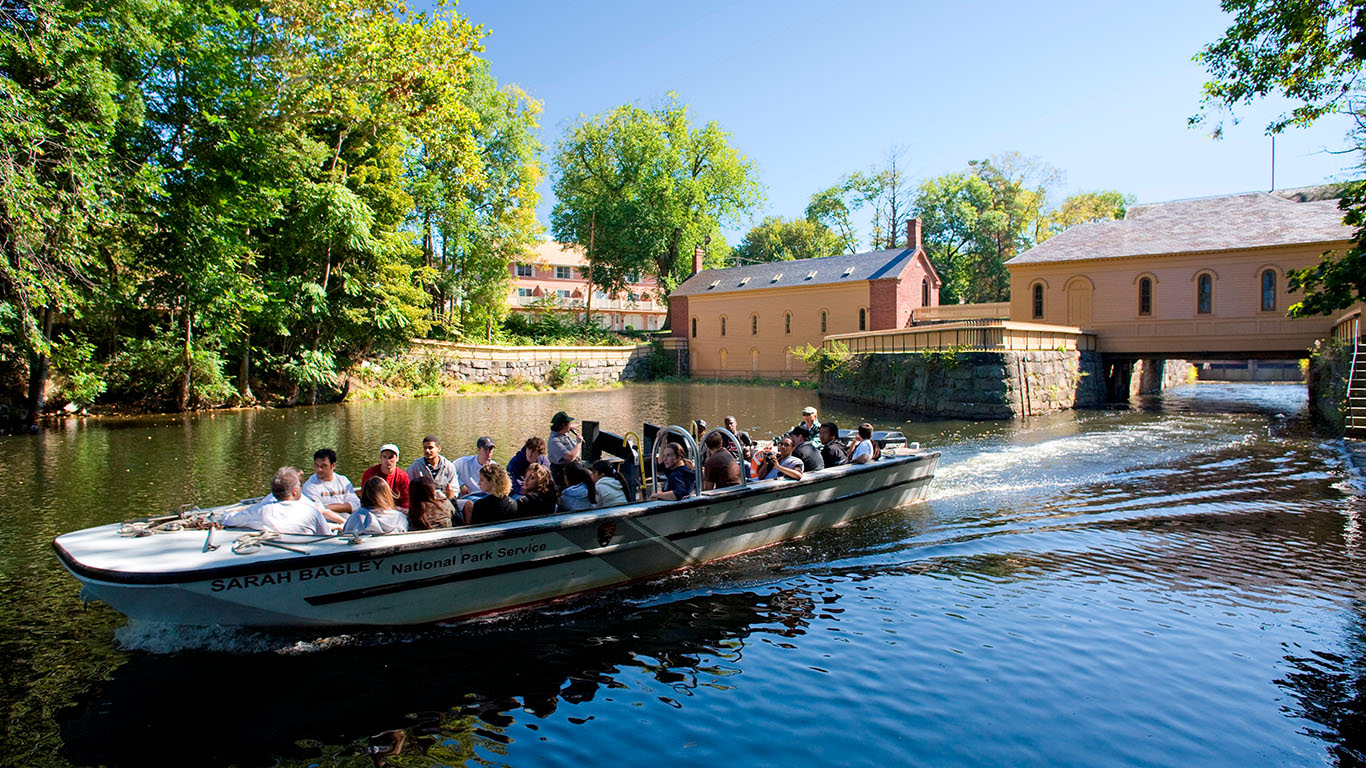
15. Lowell National Historical Park
> Total land area: 141 acres
> State: Massachusetts
> Privately owned land: 105 acres
> 5-year change in tourism: +46%
Lowell’s water-powered mills made it a major center during the American Industrial Revolution. The park explores this history and the area’s ties to the development of the country’s working class. Beat Generation icon Jack Kerouac was born in Lowell, and the national park’s Mill Girl & Immigrants Exhibit features a display of the author’s artifacts, including a typewriter and backpack.
[in-text-ad]
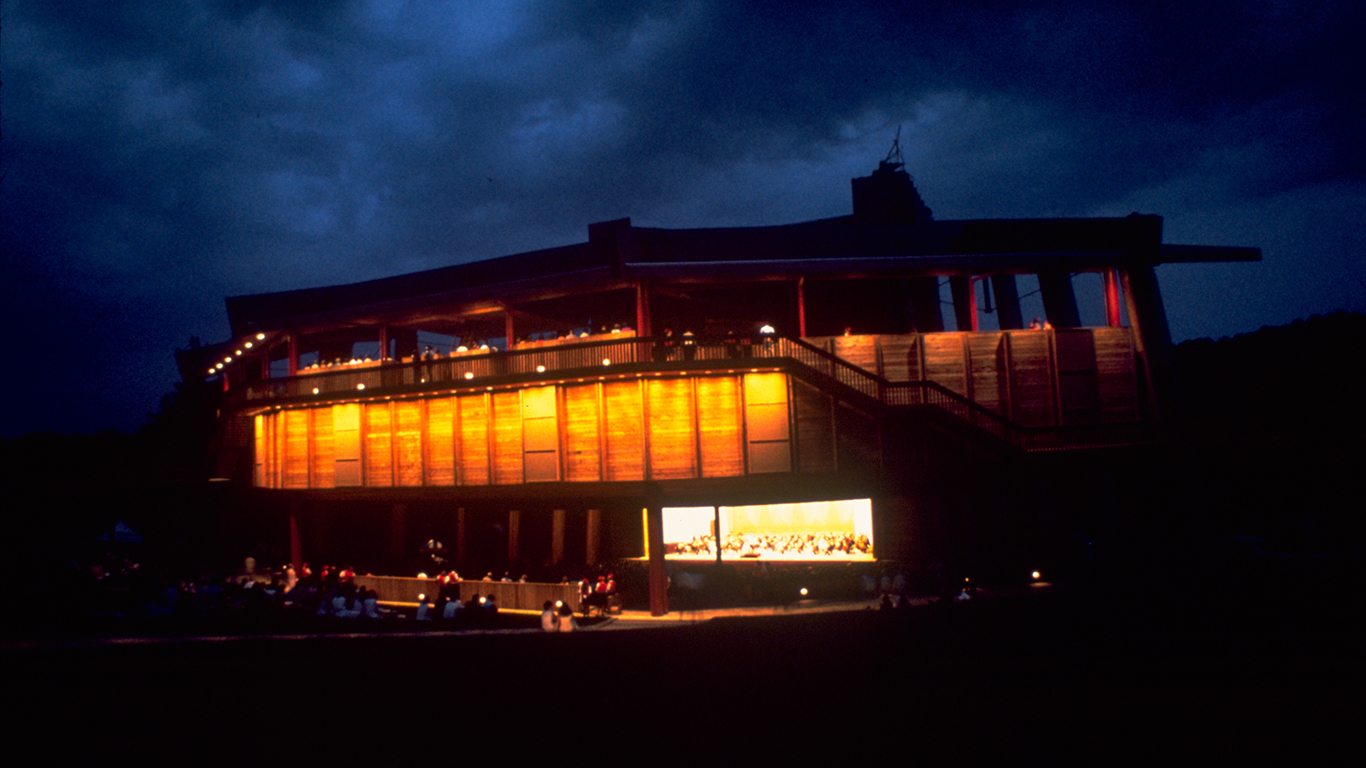
14. Wolf Trap National Park for Performing Arts
> Total land area: 130 acres
> State: Virginia
> Privately owned land: No private land
> 5-year change in tourism: +18%
Through the donation of prominent public servant Catherine Filene Shouse, the country received its first and only national park for the performing arts. Wolf Trap was opened in 1966 and holds performances from May through September.
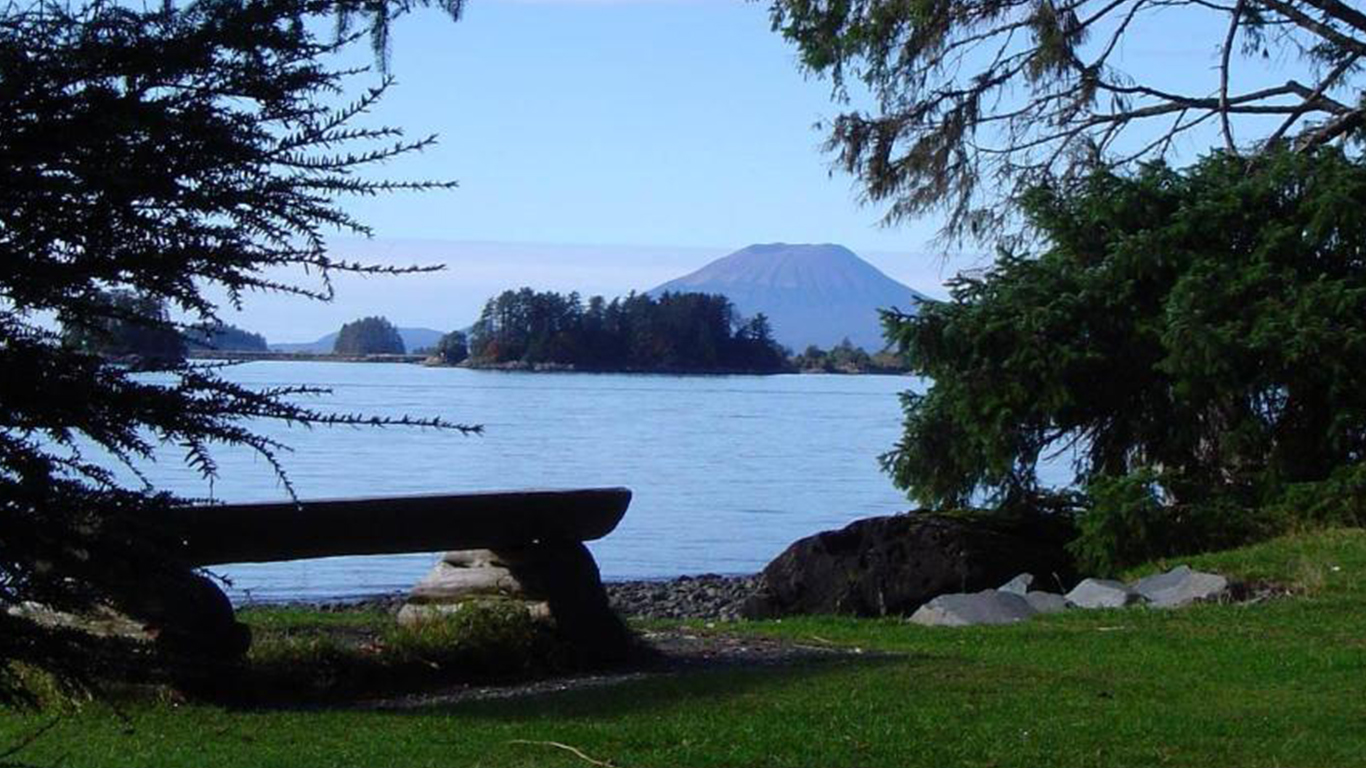
13. Sitka National Historical Park
> Total land area: 116 acres
> State: Alaska
> Privately owned land: 3 acres
> 5-year change in tourism: +16%
The park commemorates the experiences of the Tlingit or indigenous people of the Pacific Northwest and the Russians, who controlled Alaska until the U.S. purchased the territory in 1867. The Russian Bishop’s House in the park is one of only four surviving examples of Russian Colonial Style architecture in the Western Hemisphere.

12. Manhattan Project National Historical Park
> Total land area: 114 acres
> State: New Mexico, Washington, Tennessee
> Privately owned land: No private land
> 5-year change in tourism: -13%
The Manhattan Project was the name for the research and development effort that produced the first nuclear weapon. Unlike other national historical parks on the list, this one is located in three separate, non-contiguous states. In Los Alamos, New Mexico, 6,000 scientists and personnel worked on developing the atomic bomb and the sites there host an inside look of the facilities for visitors. The Oak Ridge Reservation in Tennessee was the military headquarters for the project, while the plutonium for the weapon was made at the Hanford Engineer Works in Washington.
[in-text-ad-2]
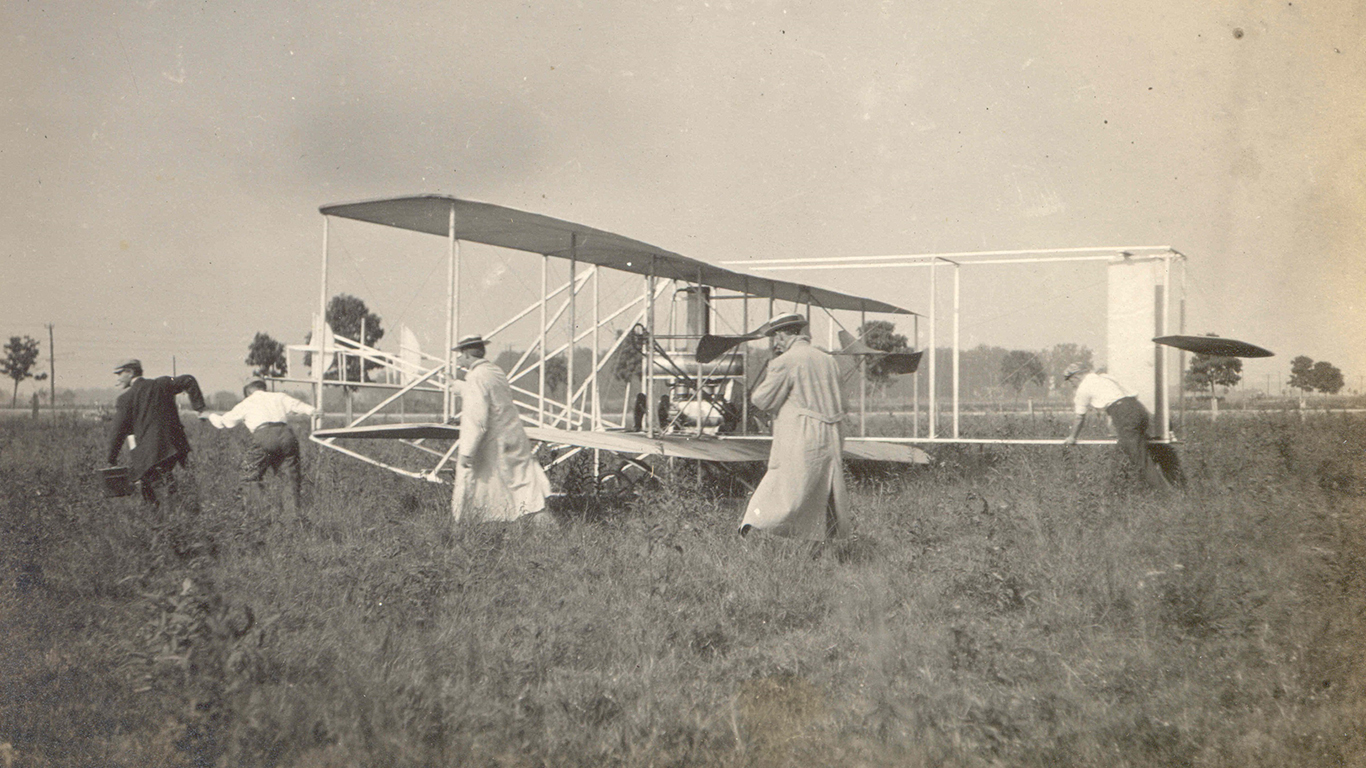
11. Dayton Aviation Heritage National Historical Park
> Total land area: 111 acres
> State: Ohio
> Privately owned land: 25 acres
> 5-year change in tourism: +40%
Dayton Aviation Heritage National Historical Park commemorates the birthplace of aviation. Wilbur and Orville Wright lived and worked in Dayton and the park includes one of their bicycle shops. There are five National Historic Landmarks and a National Register Historic District located within the park. Also in the park is the Paul Laurence Dunbar House, which celebrates the life of the African-American poet and author.
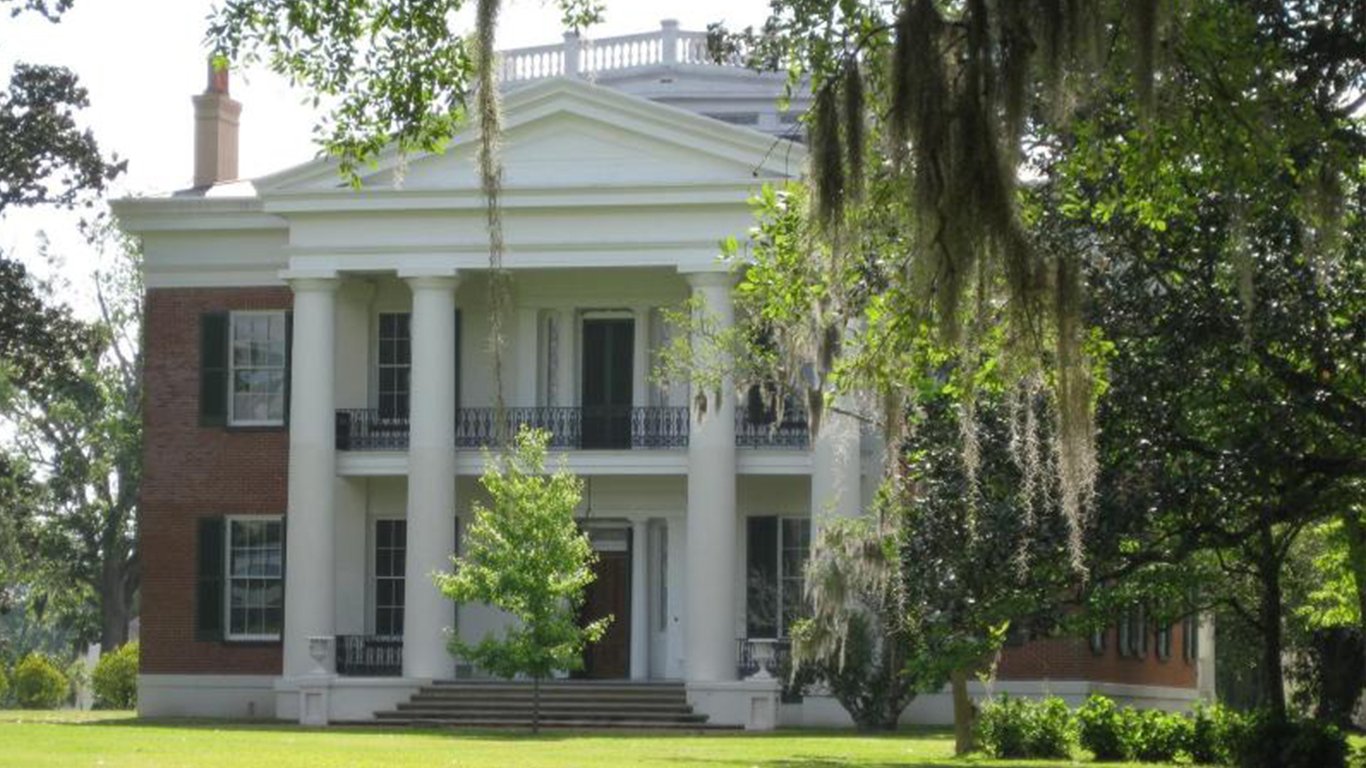
10. Natchez National Historical Park
> Total land area: 108 acres
> State: Mississippi
> Privately owned land: 17 acres
> 5-year change in tourism: -1%
The small city of Natchez, Mississippi, is home to its own national historical park that was created to teach visitors about the social, cultural and economic development between whites, blacks and Native Americans during the Civil War era. The name “Natchez” comes from the Native American people who once inhabited the region.
[in-text-ad]
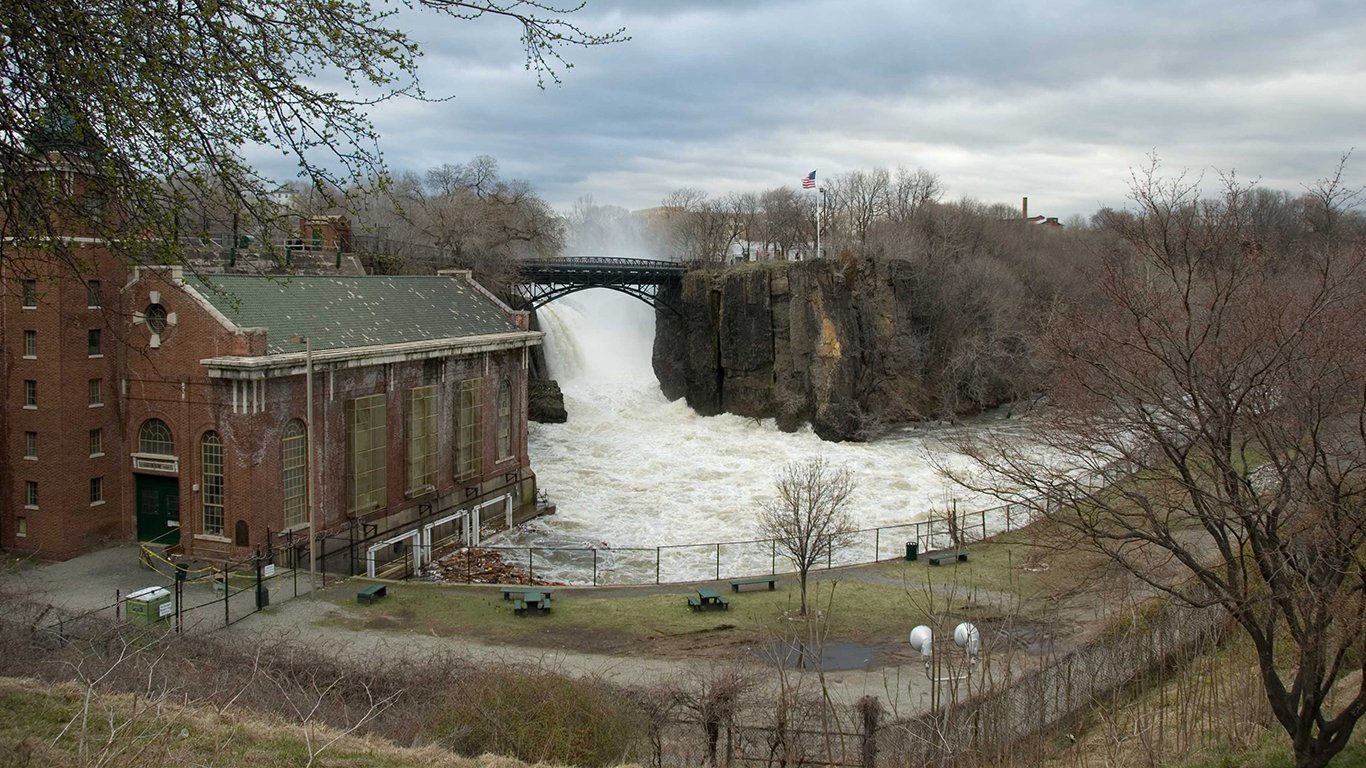
9. Paterson Great Falls National Historical Park
> Total land area: 51 acres
> State: New Jersey
> Privately owned land: No private land
> 5-year change in tourism: +125%
Paterson Great Falls National Historical Park is the site of Alexander Hamilton’s project in the late 18th century that utilized the waterfalls for industrial use. Paterson became a manufacturing powerhouse with the building of mills and factories that produced cotton fabrics, jute, railroad locomotives, and textile machinery.
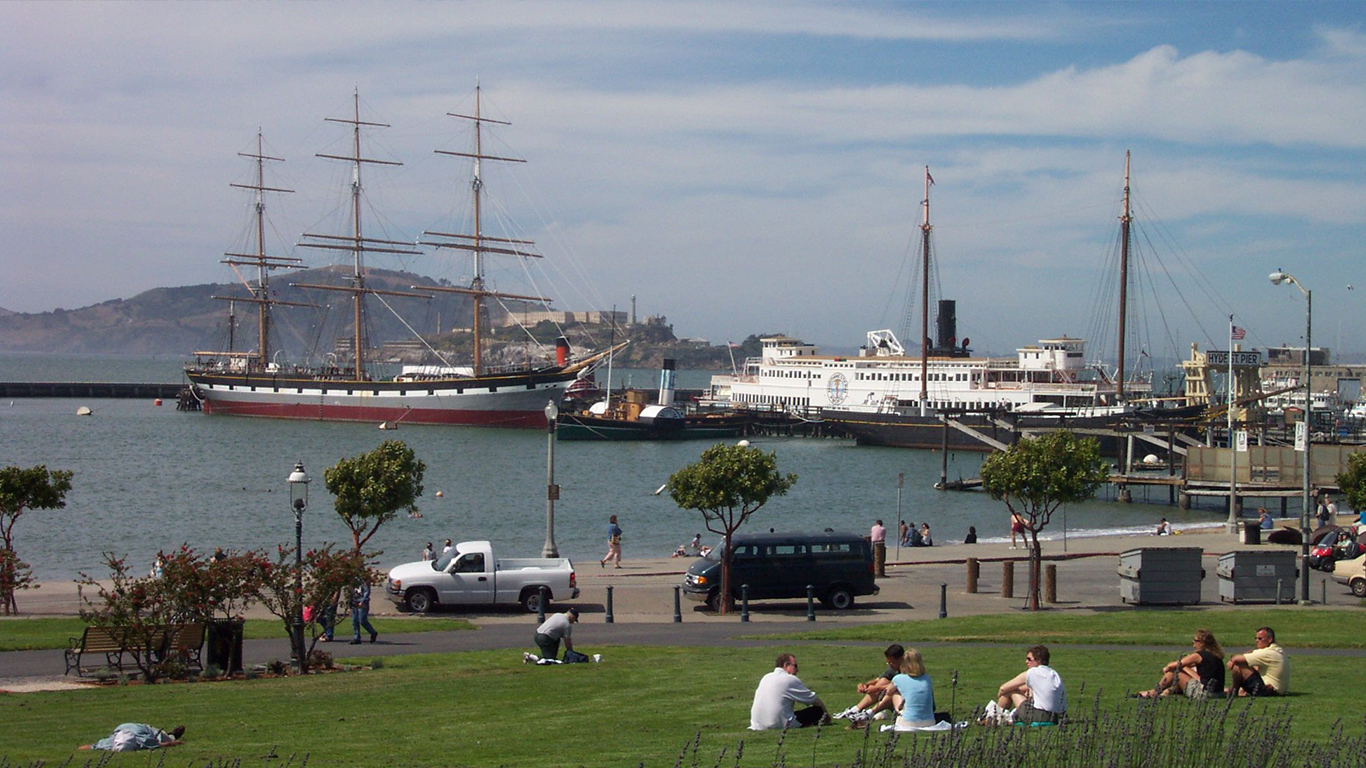
8. San Francisco Maritime National Historical Park
> Total land area: 50 acres
> State: California
> Privately owned land: No private land
> 5-year change in tourism: +3%
Established in 1988, this park is more like a museum on the water. While you can go swimming at the Aquatic Park, San Francisco Maritime is most known for its fleet of old ships dating from the late 19th to early 20th century.
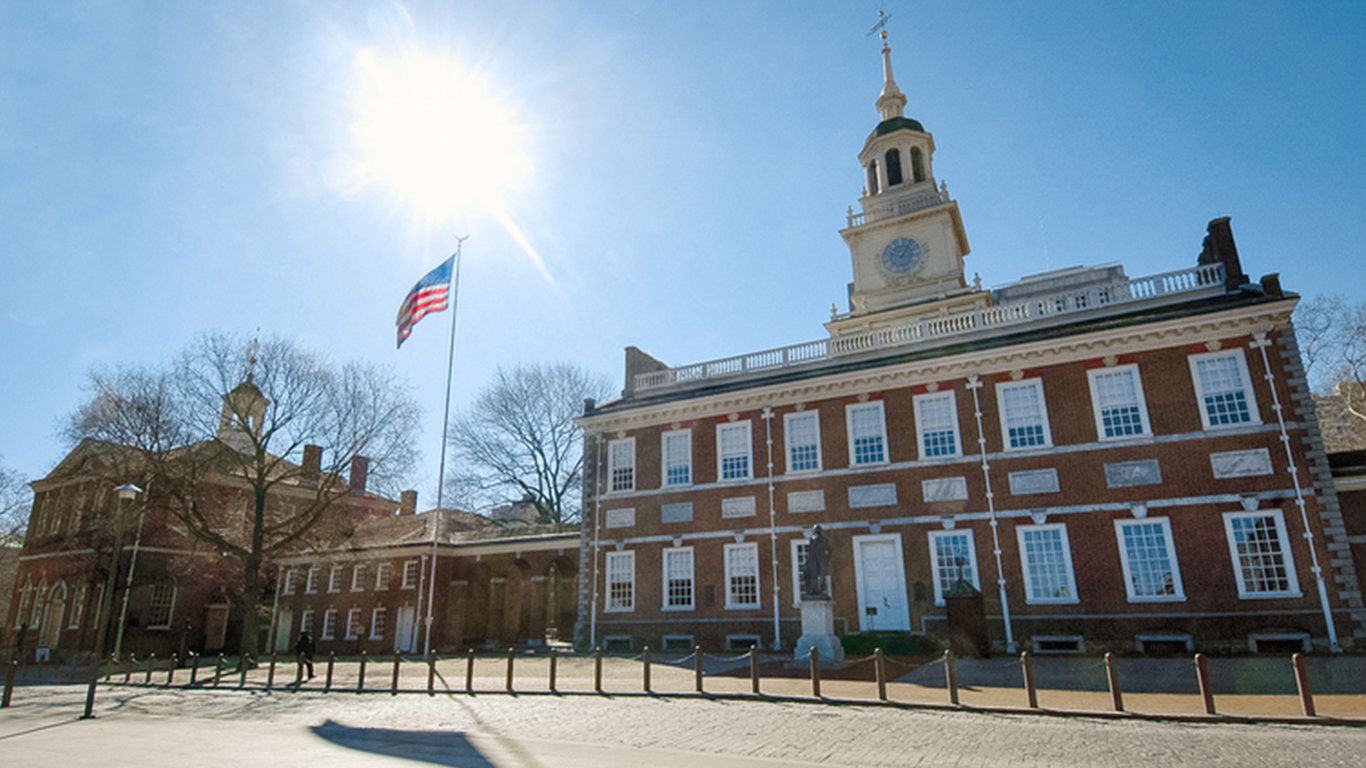
7. Independence National Historical Park
> Total land area: 45 acres
> State: Pennsylvania
> Privately owned land: 6 acres
> 5-year change in tourism: +459%
More than 5 million people visited the Independence National Historical Park in 2016. The Declaration of Independence and Constitution were both debated and signed inside Independence Hall. Nearby is the Liberty Bell, America’s iconic symbol of liberty.
[in-text-ad-2]
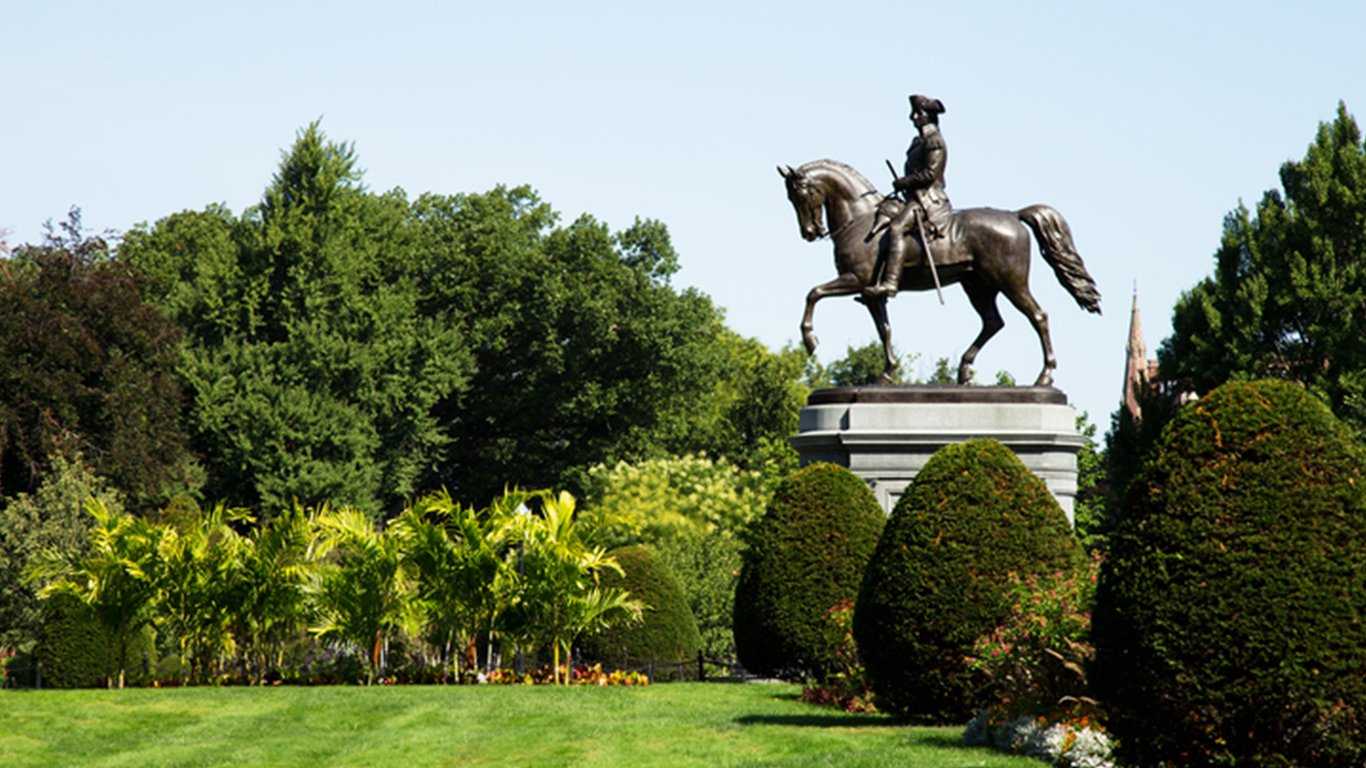
6. Boston National Historical Park
> Total land area: 44 acres
> State: Massachusetts
> Privately owned land: 1 acre
> 5-year change in tourism: -19%
Established in 1974, the Boston National Historical Park is a group of eight sites showcasing Boston’s role in the American Revolution. Seven of the sites are connected by the Freedom Trail — a 2.5-mile-long walking path through downtown Boston.
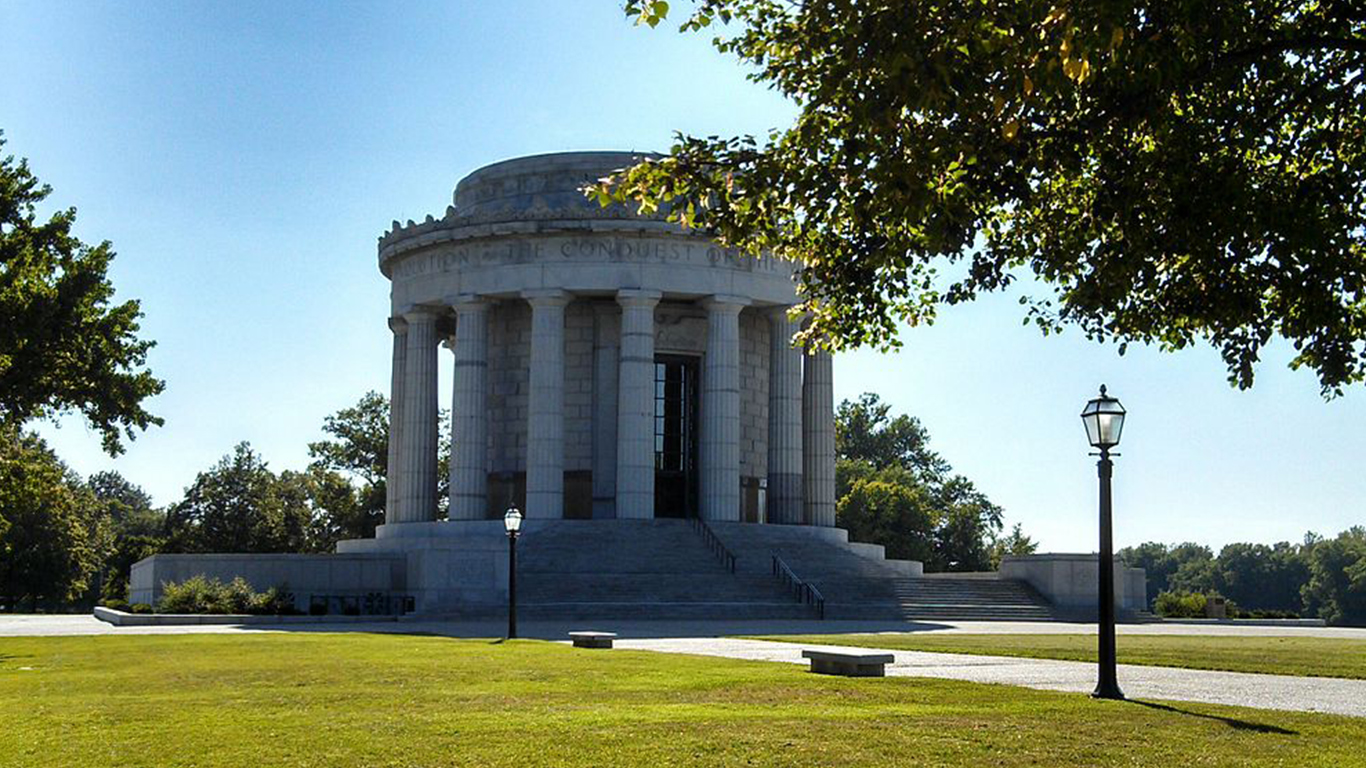
5. George R. Clark National Historical Park
> Total land area: 26 acres
> State: Indiana
> Privately owned land: No private land
> 5-year change in tourism: +7%
The George R. Clark National Historical Park celebrates the exploits of George Rogers Clark, who defeated the British at Fort Sackville in 1779. Clark’s victory weakened the British domain in the area and emboldened thousands of Americans to move west of the Appalachian Mountains. His younger brother William was one of the leaders of the Lewis and Clark Expedition.
[in-text-ad]
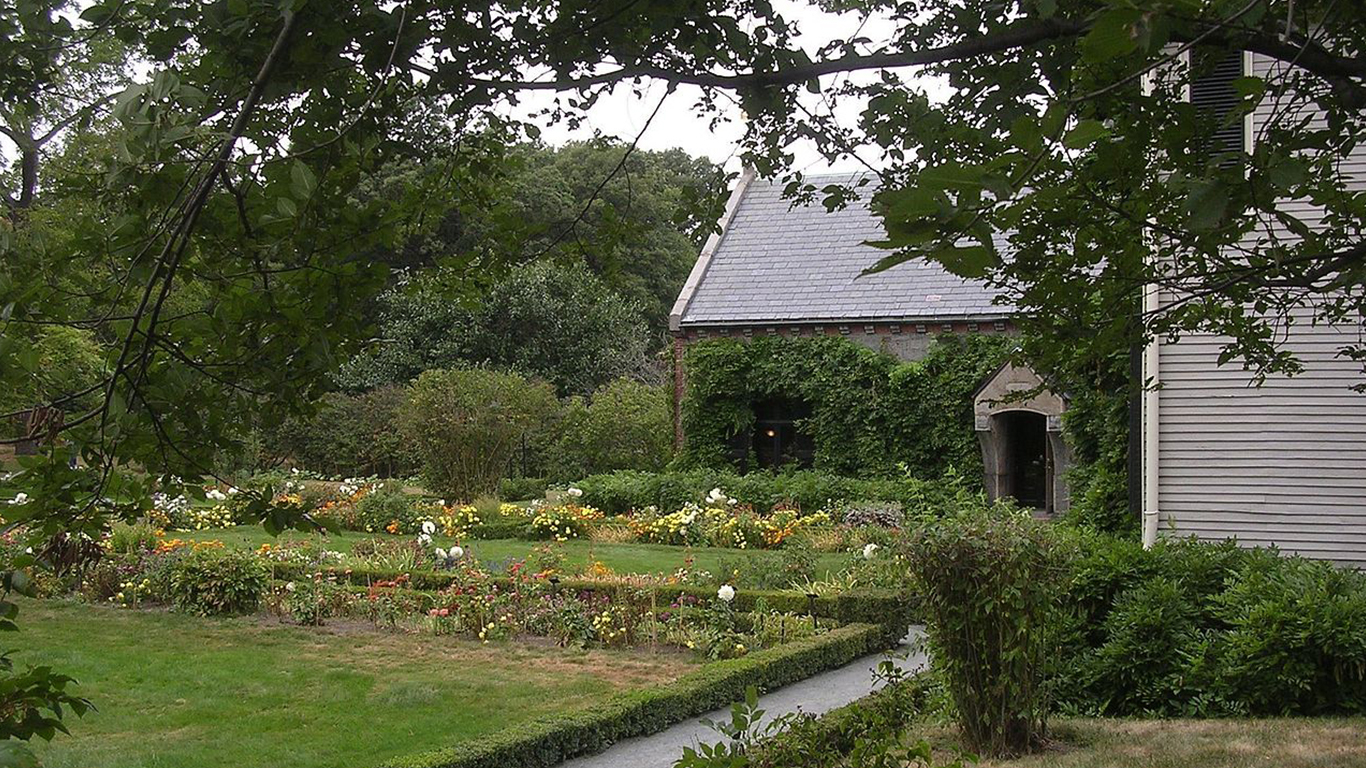
4. Adams National Historical Park
> Total land area: 24 acres
> State: Massachusetts
> Privately owned land: 11 acres
> 5-year change in tourism: +32%
Not only is this national historical park the former home of U.S. presidents John Adams and John Quincy Adams, but also their descendants from 1720 to 1927. It costs $10 to go on a tour inside and see the preserved and protected home of the family that helped shape America.
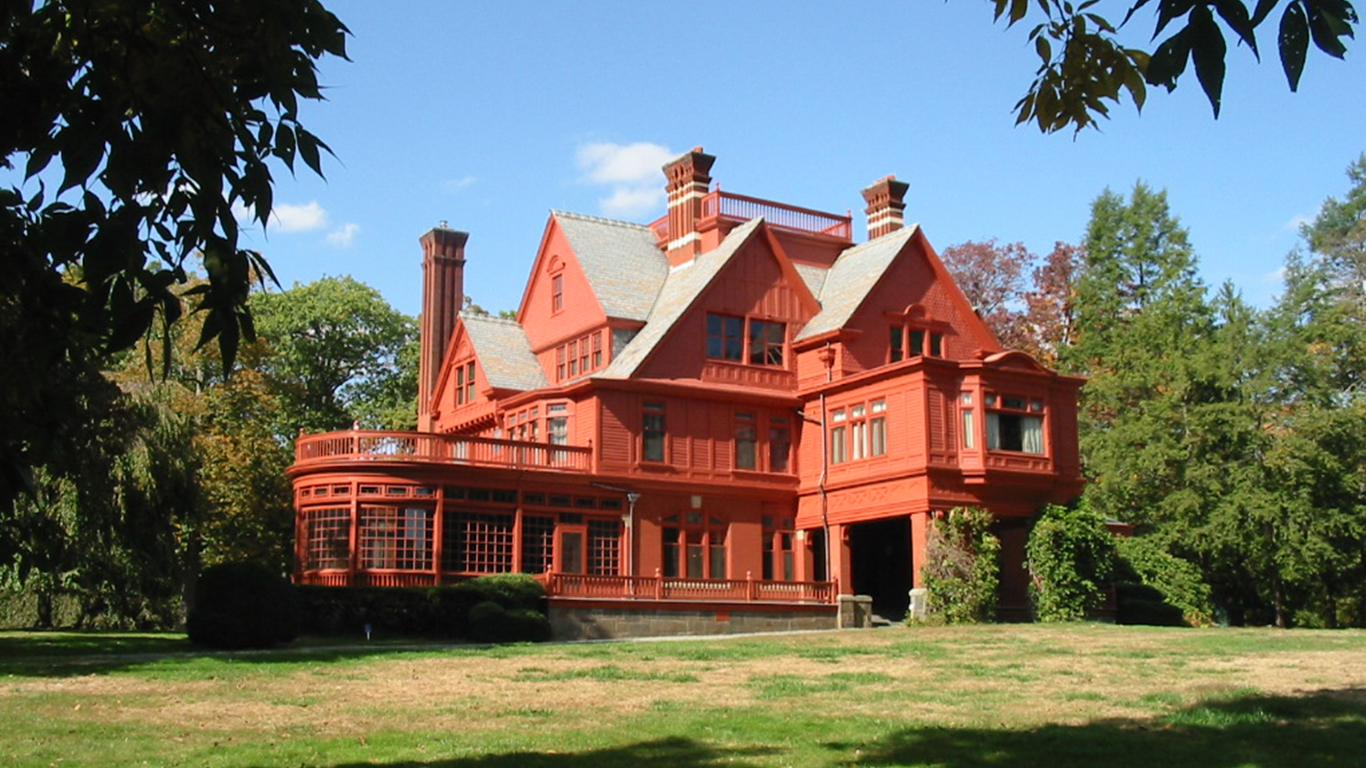
3. Thomas Edison National Historical Park
> Total land area: 21 acres
> State: New Jersey
> Privately owned land: No private land
> 5-year change in tourism: +4%
Thomas Edison National Historical Park in West Orange is the site of the laboratory and production facility where the prolific inventor developed cylinder and disc phonographs, as well as recordings and motion pictures. It is also where he built the Black Maria, the world’s first movie studio. The facility closed shortly after Edison died in 1931, but reopened as a museum in 1948, and became the Thomas Edison National Historical Park in 2009.
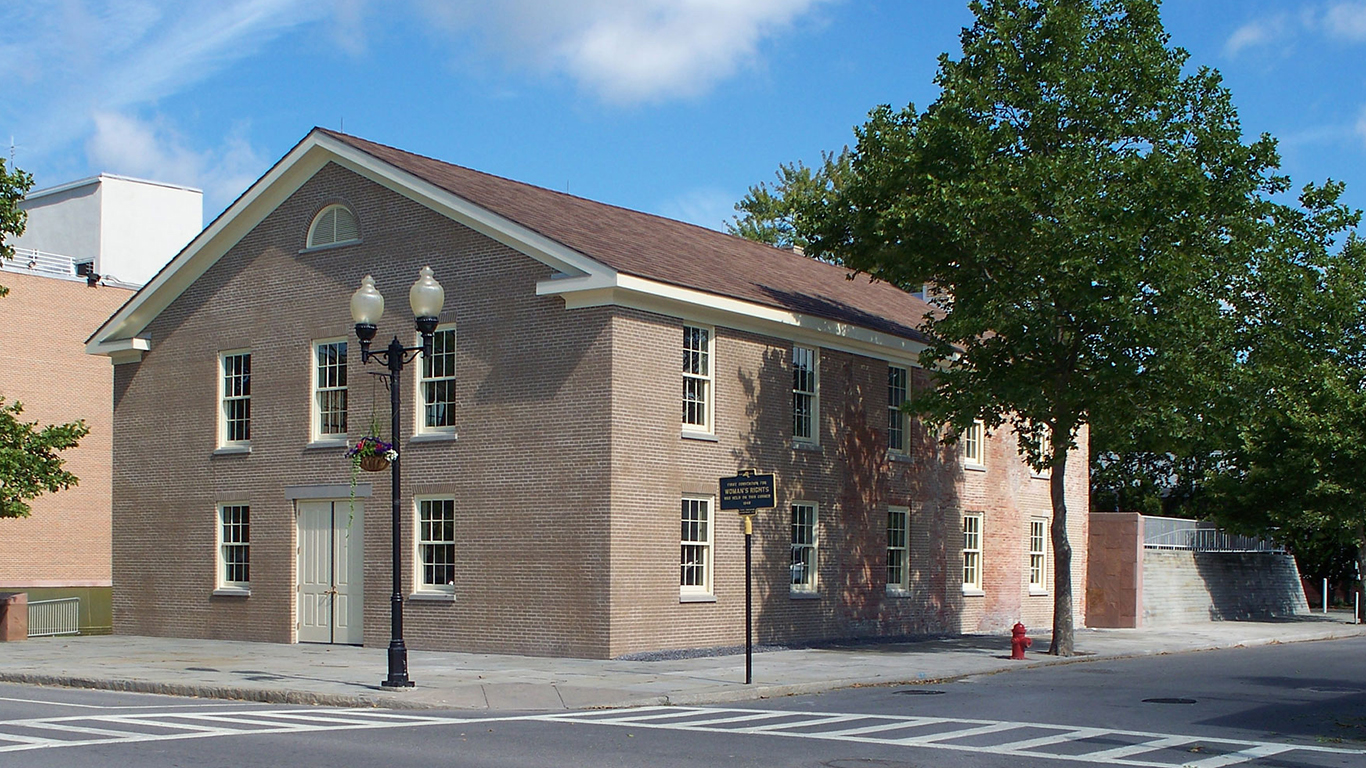
2. Womens Rights National Historical Park
> Total land area: 7 acres
> State: New York
> Privately owned land: No private land
> 5-year change in tourism: +107%
The Women’s Rights National Historical Park was created to commemorate the first Women’s Rights Convention in Seneca Falls in 1848. The convention drew more than 300 people and received 100 signatures in support of its Declaration of Sentiments that which stated: “All men and women are created equal.”
[in-text-ad-2]

1. New Orleans Jazz National Historical Park
> Total land area: 5 acres
> State: Louisiana
> Privately owned land: No private land
> 5-year change in tourism: -73%
New Orleans Jazz National Historical Park celebrates that most American of music genres — jazz. The park features walking tours of the venues and streets important in the history of jazz. Among the musical luminaries honored at the park is New Orleans’s favorite son, Louis Armstrong, as well as jazz pioneers Charles “Buddy’’ Bolden, “Papa Jack’’ George Vetiala Laine, and Sidney Bechet.
Want retirement to come a few years earlier than you’d planned? Or are you ready to retire now, but want an extra set of eyes on your finances?
Now you can speak with up to 3 financial experts in your area for FREE. By simply clicking here you can begin to match with financial professionals who can help you build your plan to retire early. And the best part? The first conversation with them is free.
Click here to match with up to 3 financial pros who would be excited to help you make financial decisions.
Thank you for reading! Have some feedback for us?
Contact the 24/7 Wall St. editorial team.